A complete identification list of birds with a red head throughout the US and Canada including photos & details about each species.
Maybe you spotted a bird with a red head and wondered what type it is. Or, maybe you’re dreaming of birds with red heads. Either way, you’ve come to the right place. This article includes the species of wild birds in the US and Canada with red heads. They could have an entire head that’s red, a spot on the head that’s red, or the entire bird is red- they’re all here!
The next step is to identify it.
A beautiful photo of each bird and their range map are included to help you identify the one you may be interested in – or hope to see one day. It doesn’t stop there. You’ll also learn about the bird’s habitat, diet, nesting habits, and what foods they’ll eat at the feeder.
The range maps are color-coded so you know if it’s a year-round bird, there to breed, migrating through, or there during a nonbreeding time.

With more than 20 years of experience attracting backyard birds to my yard (Wisconsin), I’ve studied all of the red-headed birds in my area so I have the information you’re looking for. For the remaining red-headed species, I rely on my trusty sourcebooks and friends at The Cornell Lab of Ornithology to guide me.
My hope is that this article will help you easily identify the bird with a red head that you saw or plan to see one day. So let’s get at it. The first section includes birds with an all-red head followed by birds with partial red heads or just a bit of red on their head.
Birds with All Red Heads
Hepatic Tanager
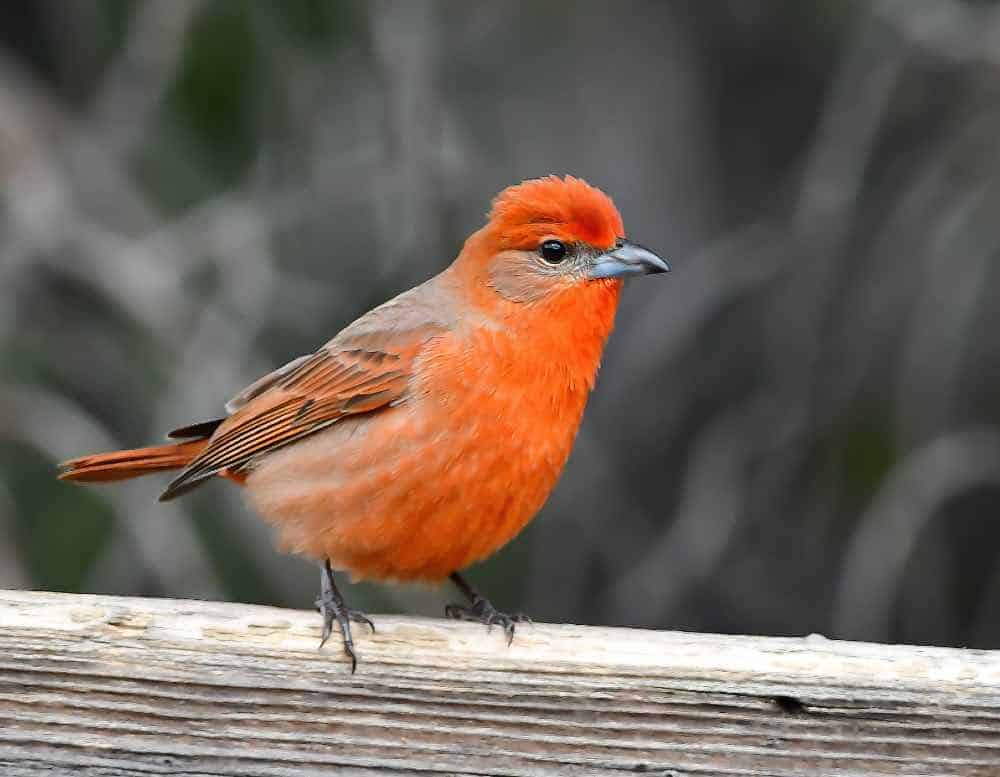
| Appearance | A small to a medium-sized bird that varies in size from 4 – 8″, dark red all over with streaks of gray, thick gray beak, and long tail. Female and juveniles are yellow. |
| Diet | Primarily insects and spiders. Also, dine on fruit. |
| Feeder Food | Do not commonly visit a feeder. |
| Habitat | Open wooded areas in a few southeast states |
| Nesting | Wide almost flat nest of grass, twigs, and other plant material. 1 brood/season, 3-5 eggs/brood. Eggs are blue/green with specs of brown/purple. |
Range Map
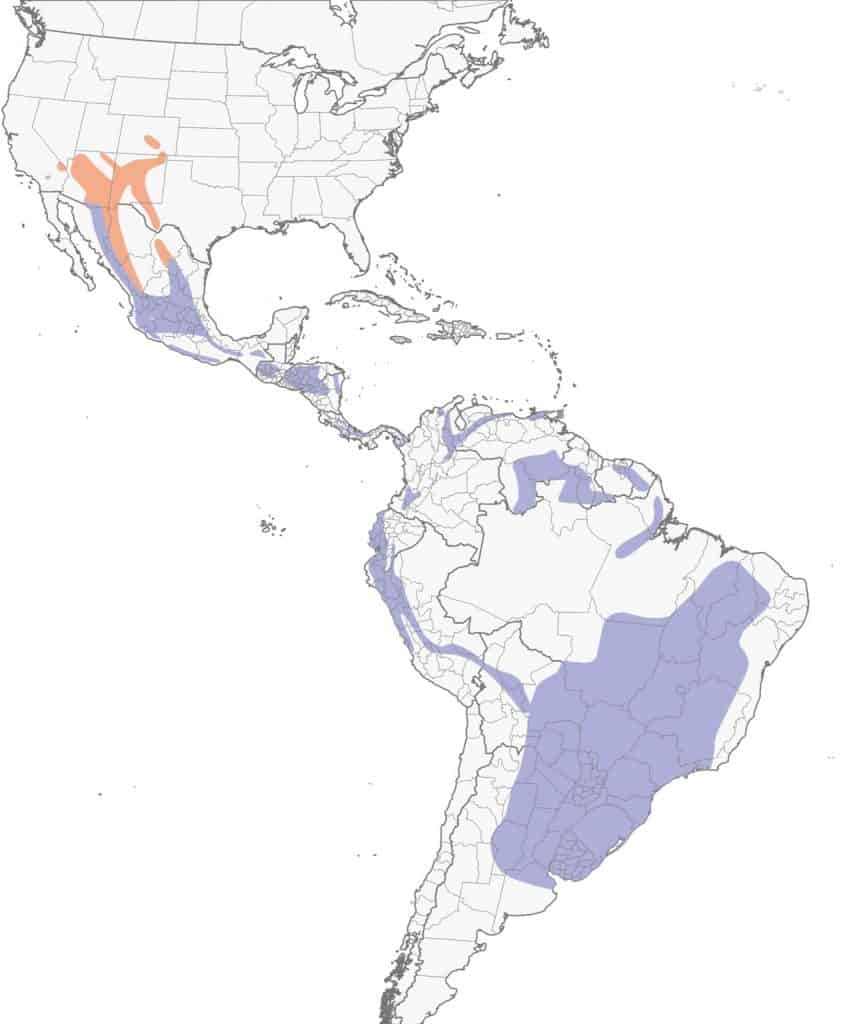
House Finch
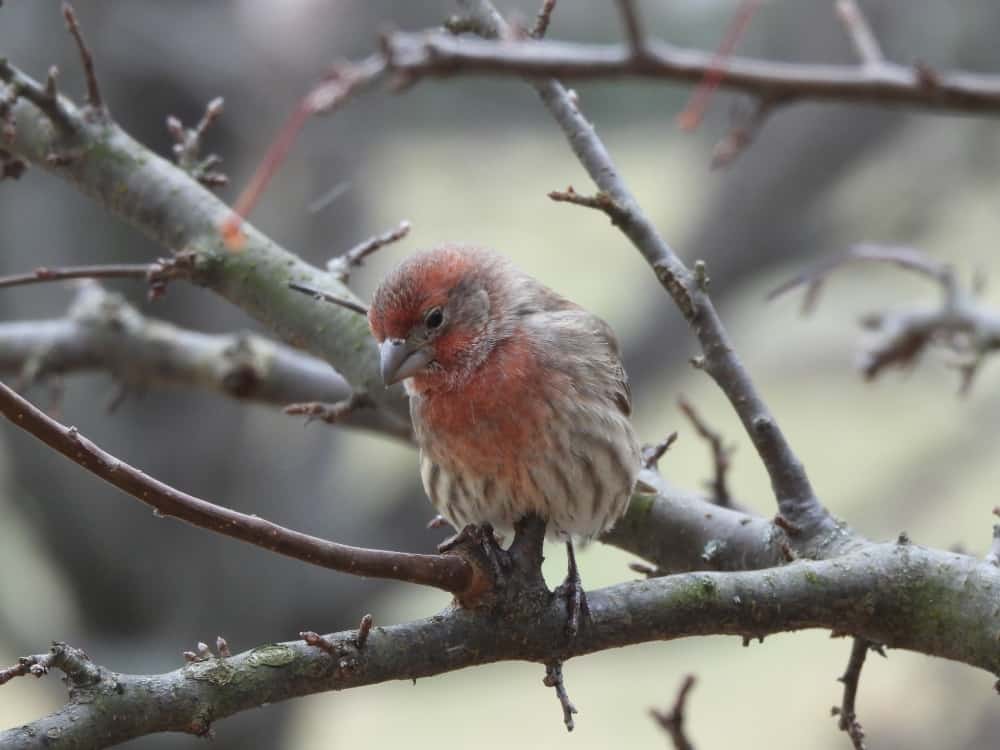
| Appearance | Small bird about 5″ long, orange/red face chest, and rump. Brown wings streaked with white. White belly with brown streaks. The Female and juvenile are brown with streaks of white. |
| Diet | Seeds, fruit, tree buds. |
| Feeder Food | Black oil sunflower seed is their favorite. |
| Habitat | House finches are found in the western and eastern parts of the US. They prefer to live around human dwellings (buildings, backyard trees, shrubs, barns. Also are found in parks and other urban areas. |
| Nesting | Nest: Small cup about 3-7″ wide, constructed from stems, leaves and plant roots, and feathers. The nests are built in coniferous or deciduous trees or even any place that holds a nest (ledges, vents, hanging plants). Broods: 1-6 broods/season Clutch: 2-6 eggs/brood (typical is 4-5) Egg color: Eggs are pale blue and speckled with black and purple dots. Egg size: 0.6 – 0.8 inches by 0.5 inches Incubation: 13-14 days and the young fledge between 12-19 days. |
| Migration | House finches are not migrators They remain in their year-round range for all seasons. Year-round range: Every US state except North & South Dakota, southern Ontario & British Columbia, and Mexico. |
Range Map
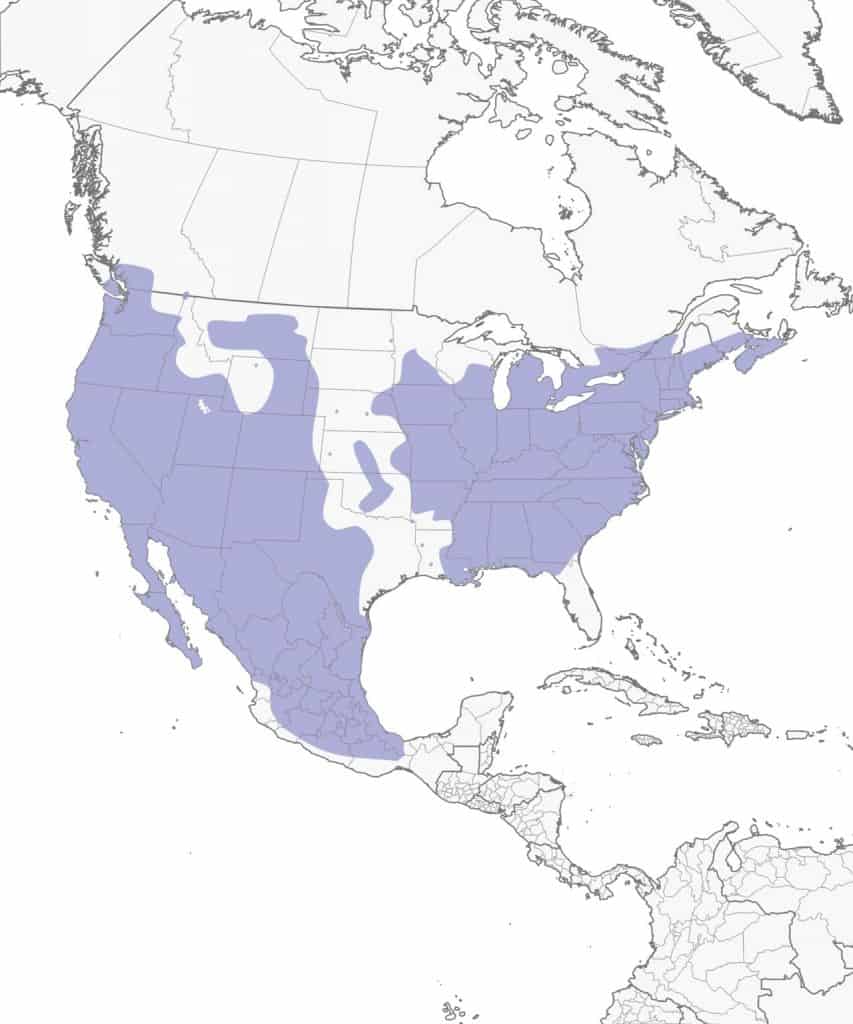
Northern Cardinal
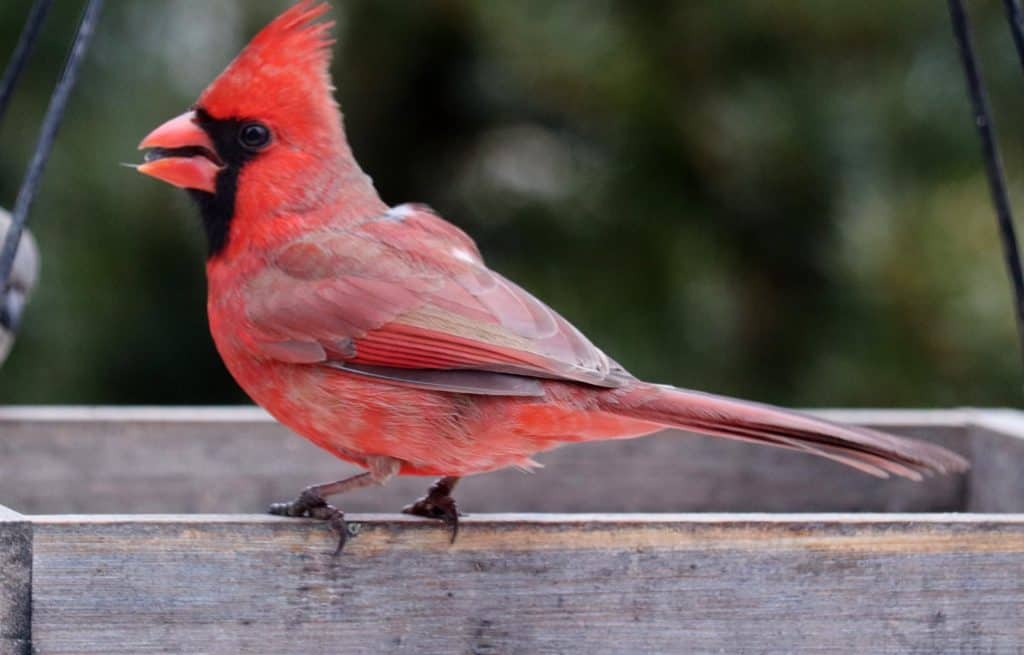
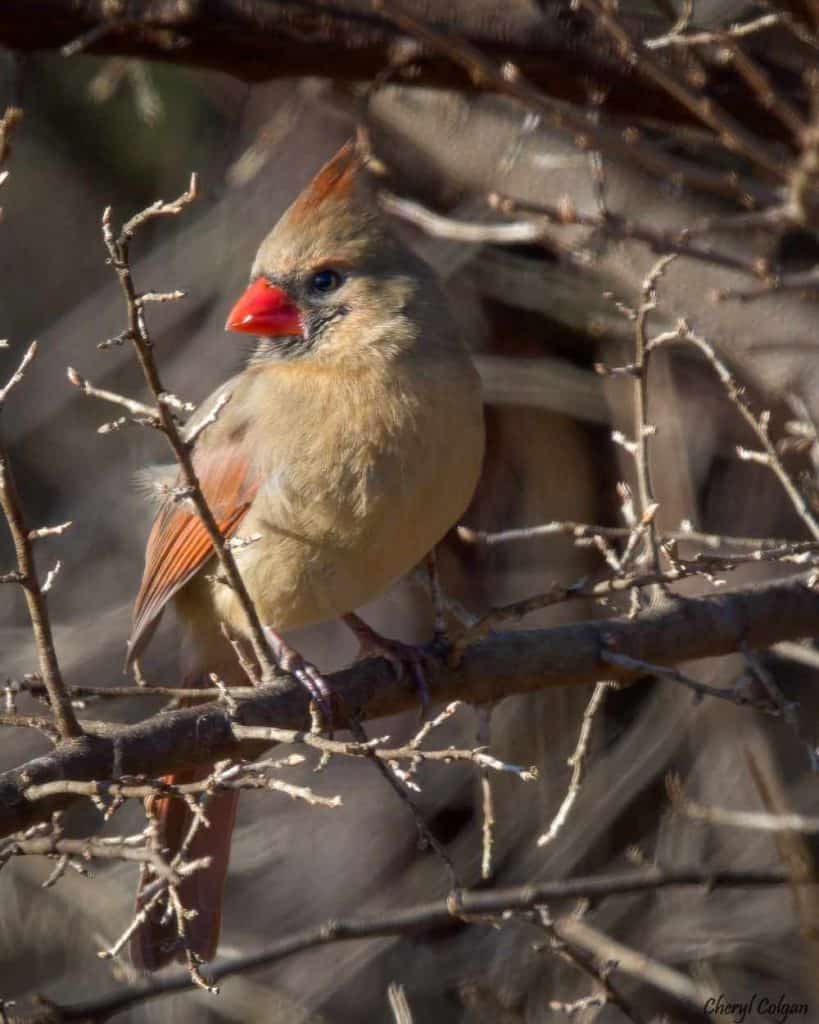
Appearance: Northern cardinals are medium-sized bright red birds about 8 1/2″ long with a black mask, red crown, orange beak, and black areas on wings and tail. The female also has an orange beak but her body is buffy brown with tinges of red on her wings, tails, and crest. The mask around her fact is charcoal.
Diet: Insects, spiders, centipedes, snails, and slugs. Fruit and seeds from plants.
Feeder food: Black-oil sunflower seed, safflower seed, mealworms, striped Sunflower seed, hulled peanuts, and cracked corn.
Habitat: Edges of wooded areas to thickets, tangled vines, city parks, and our backyard gardens.
In the southwest live around desert washes, areas thick with mesquite, and along the riverbanks of wooded areas.
Nesting: Open-cup nest in a dense shrub about 3-10′ up. They have 2-3 broods/year, and 1-5 eggs/brood that are beige with brown spots. Incubation is 12-13 days.
Migration: Northern cardinals are not migrators. They remain in their year-round range every season of the year.
Year-round range: Eastern half of the US, Arizona, New Mexico, and Mexico.
Range Map
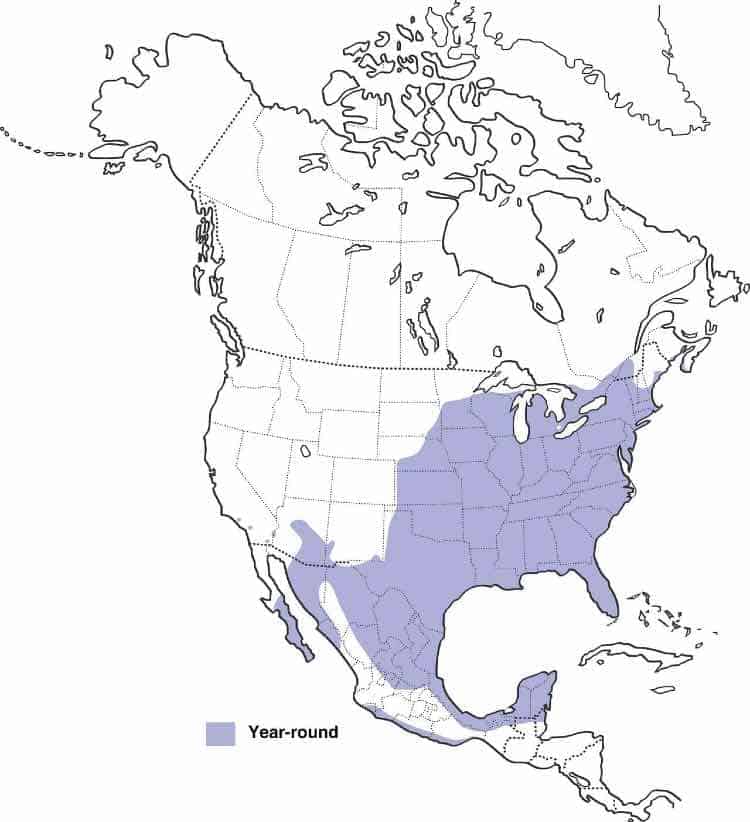
Pine Grosbeak
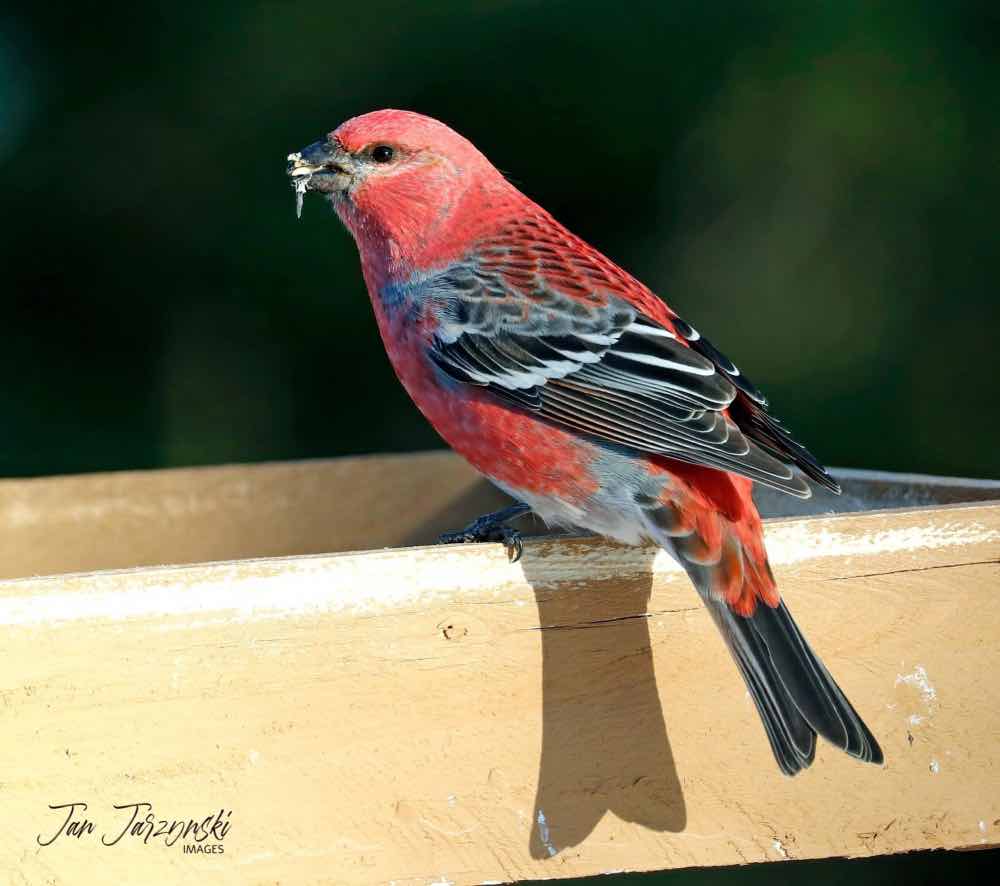
| Appearance | Sturdy bird approx 8-10″ long, soft pinkish-red with gray & charcoal body, short charcoal beak, medium tail with black tip, wings of black, white, and red. No crown. The Female is gray with a yellow head and tail. |
| Diet | Mostly seeds and fruits from their habitat (pine trees). Sometimes supplements with insects. |
| Feeder Food | Black-oil sunflower seeds and suet. |
| Habitat | Open areas with coniferous trees and deciduous trees in winter. |
| Nesting | About 20′ up in evergreen trees rests their rather large nest constructed with roots and twigs then lined grass, pine needles, and feathers. 1 brood/season, 3-4 eggs/brood, incubation lasts 13-14 days and they fledge between 13-20 days. Eggs are light blue and dotted. |
Range Map
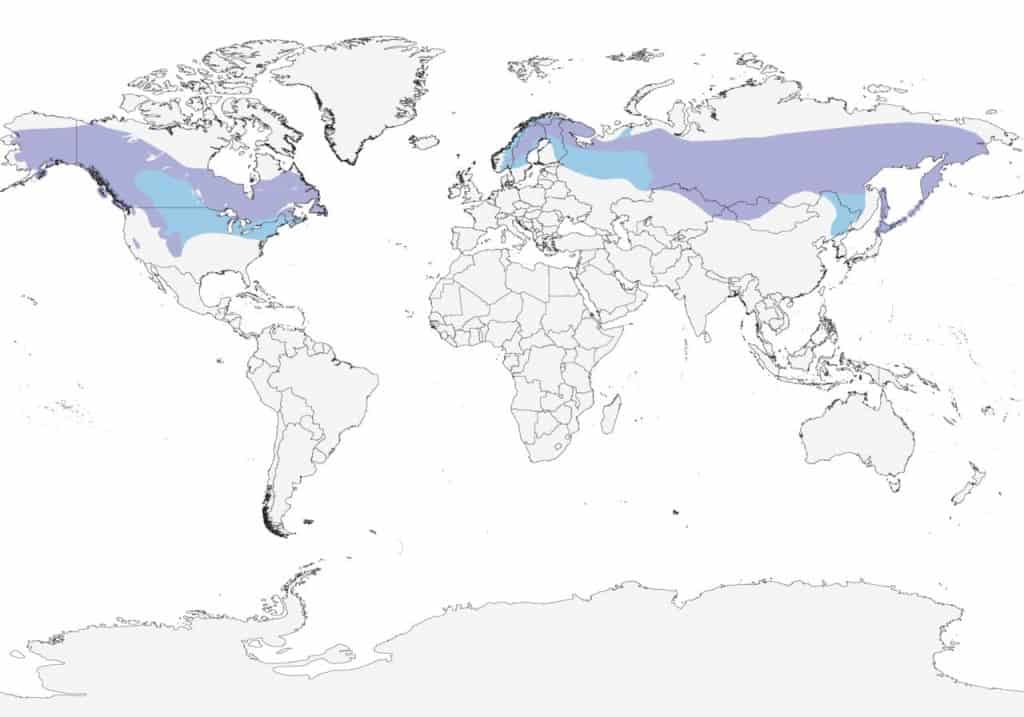
Purple Finch
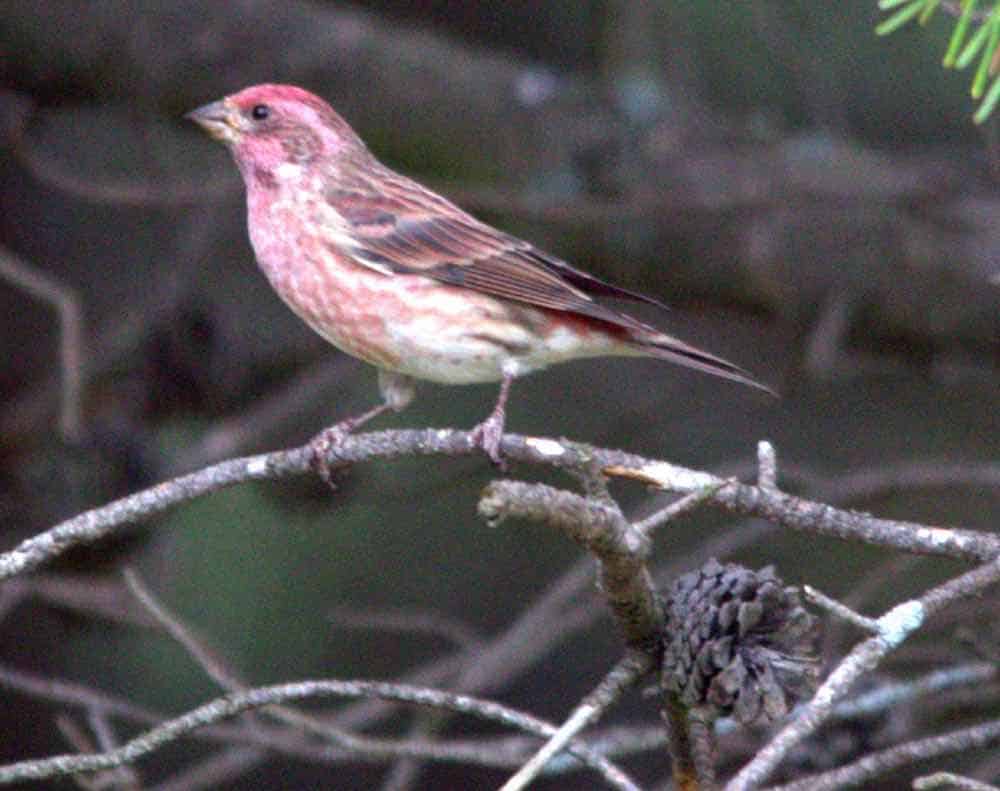
Appearance: Small bird about 6″ long with a raspberry-red head with lighter shades on the breast, back, and rump. The wings and tail are brown. Females are brown with brown striped breasts and white streaks across their eyes.
Diet: Seeds, insects, and fruit.
Feeder food: Black oil sunflower seeds are their favorite.
Habitat: Prefer coniferous forests in summer along with mixed forests near streams and tree-lined backyards.
Nesting: Purple finches’ nests are found anywhere from 2-60′ off the ground on a tree branch and constructed from twigs, sticks, and plant roots. Lined with grass and hair.
Migration: Purple finches are migrators. While many of them remain in their year-round range, others migrate north in the spring to breed and raise young. Then in the fall, the migrators head south for the winter.
Year-round range: The Pacific coast of Washington, Oregon, and California, and Canada’s British Columbia.
Breeding range: Just east of the year-round range along the Pacific northwest states and Canada’s provinces except for Nunavut.
Winter range: The eastern half of the US (except New England) and southern Arizona.
Range Map
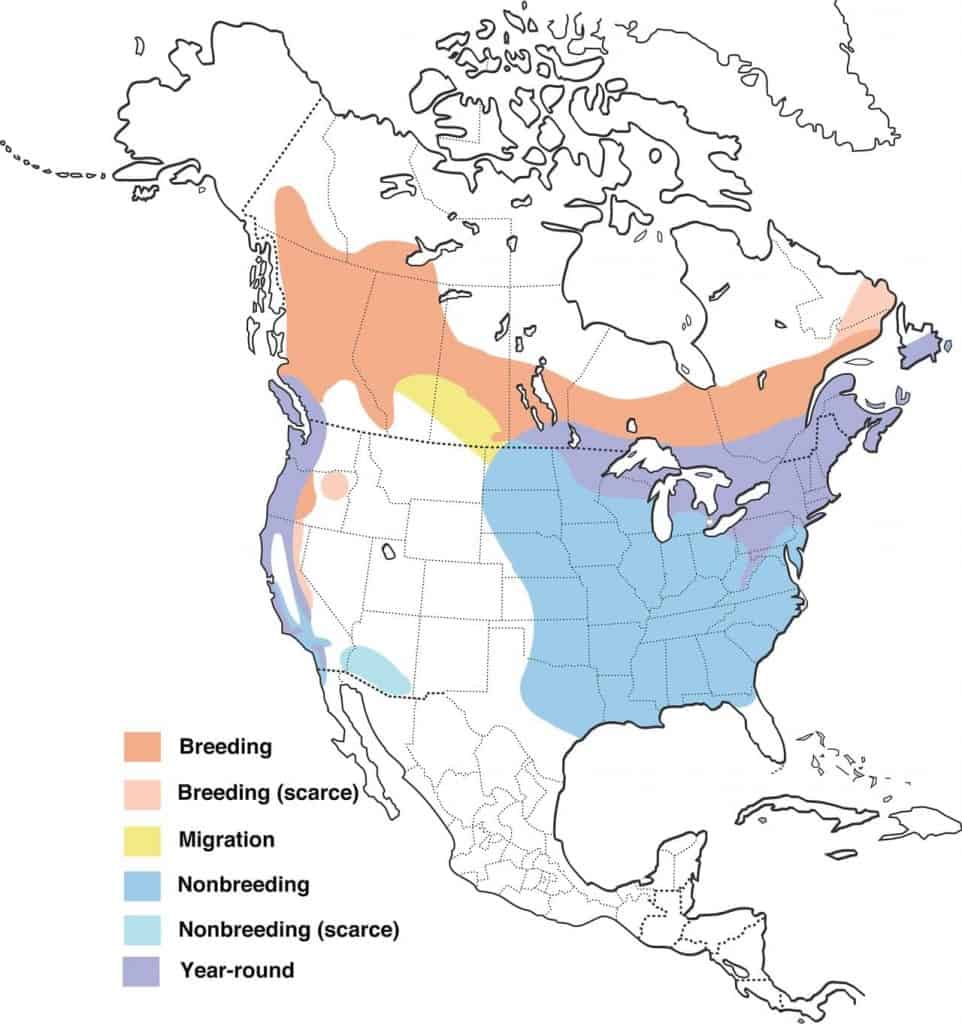
Red Crossbill
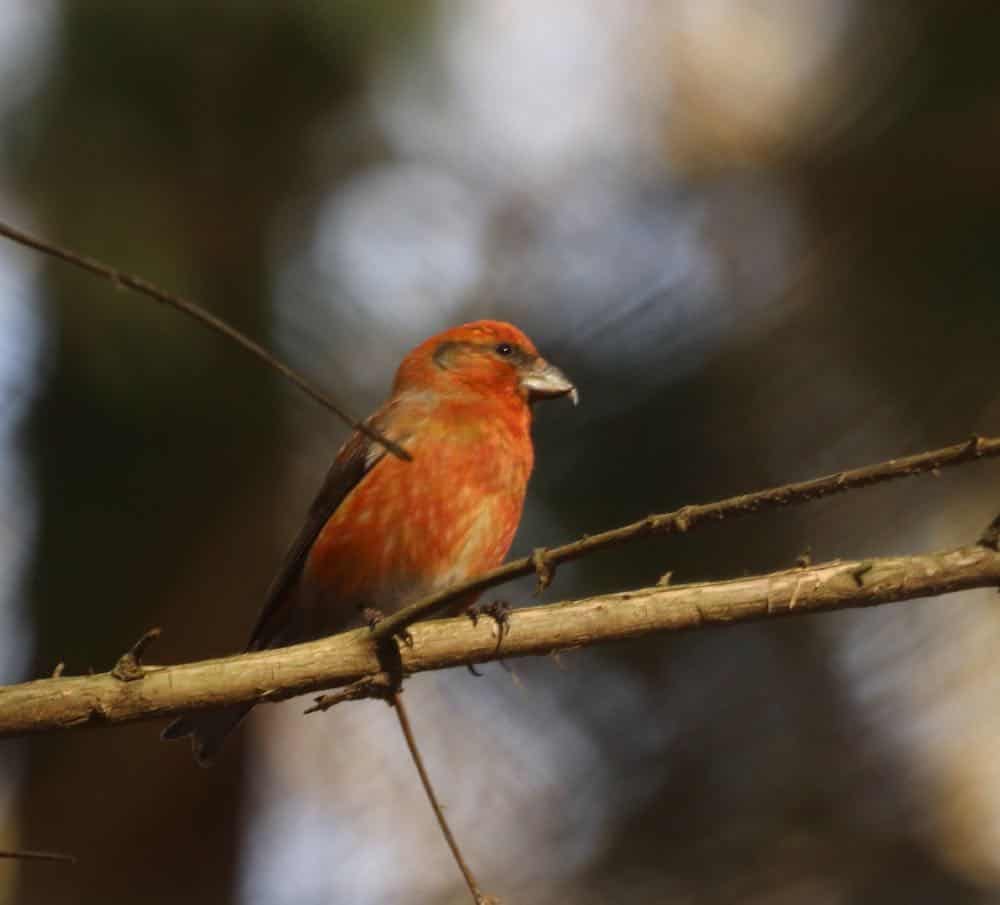
Appearance: The red crossbill is a small bird about 6.2″ long, dark red-orange with brown singes and tail. Their bill is long, pointed, and “crossed”. A brighter color of red on the head and rump. No crown. The female and young are pale yellow and gray.
Diet: Seeds – especially those inside pinecones. The bird’s “crossbill” is designed to pry open pinecones to get at the seed inside.
Feeder food: Black oil sunflower seed.
Habitat: Red crossbills either remain in their year-round territory for winter or expand south to create a wide winter range that includes Canada, the Pacific Northwest, states west of the Great Plains, Minnesota, Wisconsin, Michigan, New York, Vermont, Connecticut, and Massachusettes. They prefer mature coniferous forests.
Migration: While many red crossbills remain in their year-round range all seasons of the year, many migrate south for the winter.
Year-round range: The western half of the US, Mexico, and all Canadian provinces except Nunavut.
Winter range: Primarily northern Nevada, eastern Montana, North Dakota, South Dakota, northern Kansas, southern Minnesota & Wisconsin, northern Michigan, Pennsylvania, and New England. To a lesser degree, the remaining southern US states.
Range Map
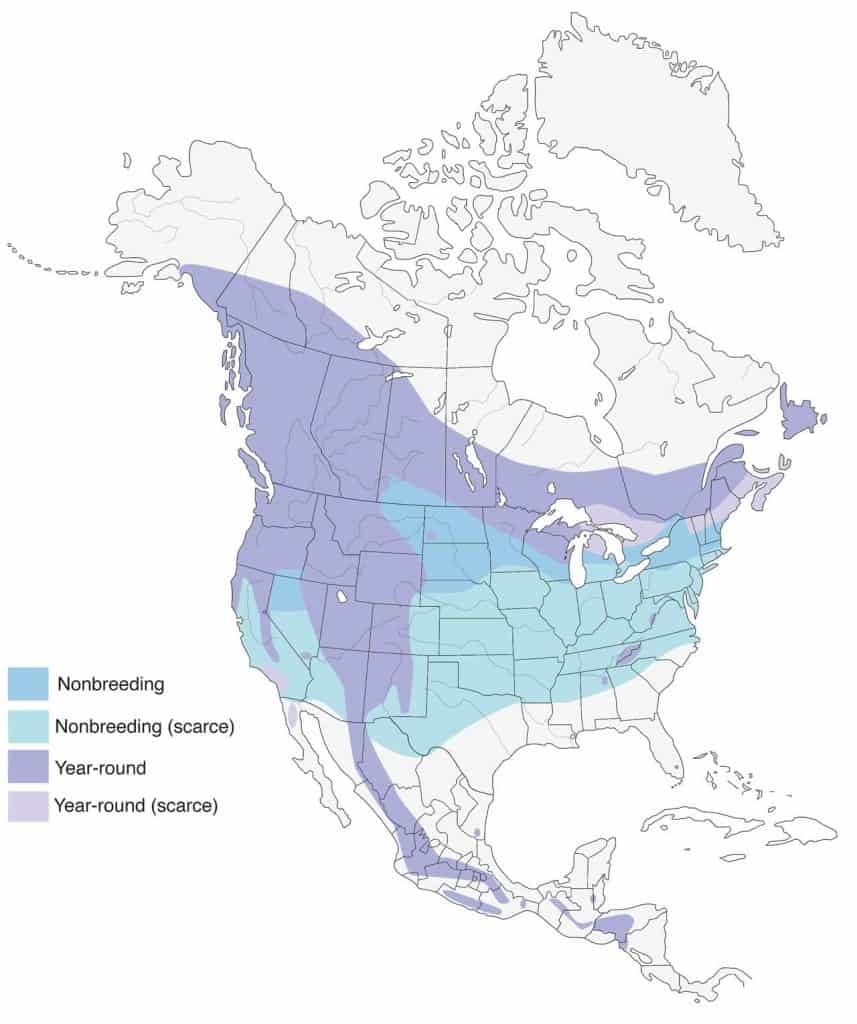
Red-Breasted Sapsucker
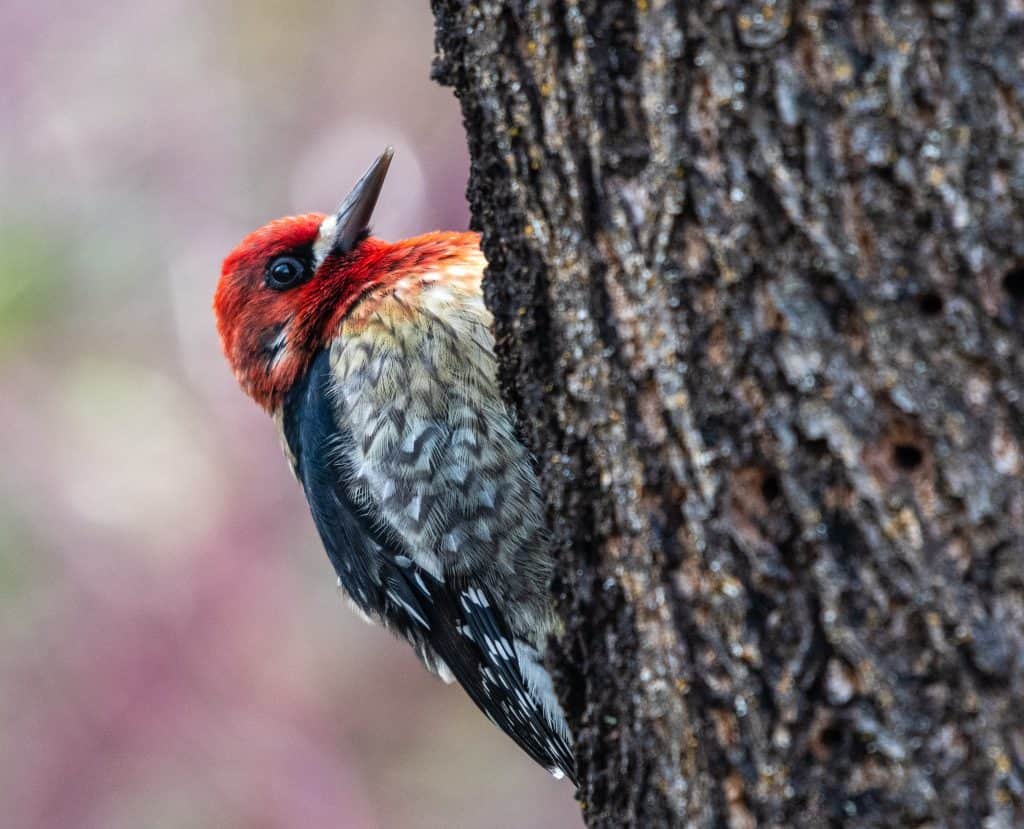
Appearance: The red-breasted sapsucker is a medium-sized woodpecker about 8-9″ long. They have a red head with black on either side of their face from the base of the bill to the front of the eyes (area referred to as lores), and white tuffs of feathers at the base of the bill. The upper back is black with two narrow stripes and buff-colored spots. Wings are black with white underwings, belly is yellow in center. Females are similar. Juveniles have dark brown or olive-colored heads instead of red, sides are charcoal, and the center of the belly is a faint yellow. dark brown or olive
Diet: Tree sap, cambium (cell layer beneath the tree bark), insects, and small fruits.
Feeder Food: Suet.
Habitat: During the breeding season they can be found in mixed conifer forests, especially when mixed with aspens, or in open areas with Douglas firs and spruce trees.
Nesting Behavior: Red-breasted sapsuckers are cavity nesters. They won’t reuse a nest but may excavate a new cavity in the same tree the following season. They have 1 brood/season, 4-7 white eggs/brood, incubate for 14-15 days, and fledglings leave the nest after about 23-28 days.
Migration: Some, but not all, red-breasted sapsuckers are migrators. Many remain in their year-round range for all seasons of the year. In spring, the northern migrators leave the year-round range and head north to inland British Columbia while those in the southern part of the year-round range head a bit east into inland California. Then in fall, those that breed in the north migrate west to the coast of British Columbia, south to the coast of California, inland California, or western Nevada for the winter.
Year-round range: Along the pacific coast from British Columbia, Canada, Washington, Oregon, northern California as well, and inland southern California.
Breeding range: Inland in Canada’s British Columbia as well as Washington and California.
Winter range: While many red-breasted sapsuckers remain in their year-round range all seasons of the year, some head south throughout California, northwestern Nevada, and a bit into Mexico.
Range Map
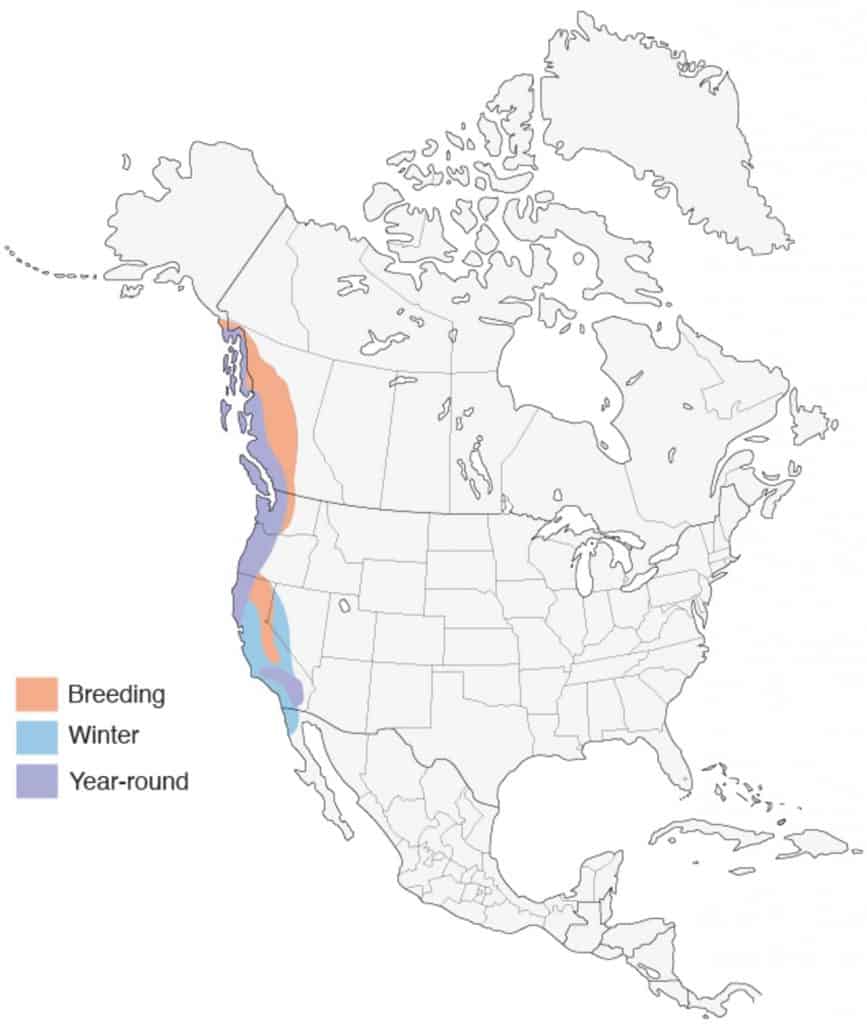
Red-Headed Woodpecker
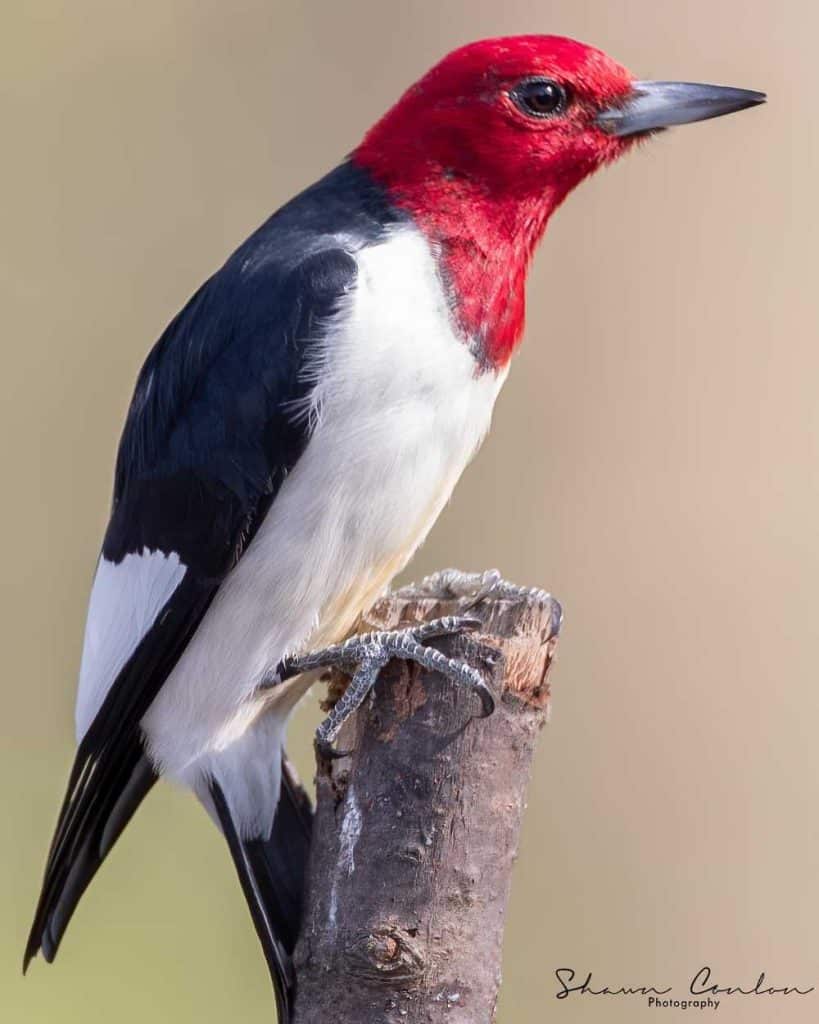
Appearance: Red-headed woodpeckers are medium-sized birds about 9″ long with a red head, black back, white rump, chest, and belly. Also has white patches on its wings, black tail, and gray legs and bill. The female is the same as the male.
Diet: Insects, fruit, nuts, and seeds.
Feeder food: Suet and hulled peanuts.
Habitat: During the breeding season, they prefer open woodlands especially when ample deciduous trees are present, as well as short-grass meadows, pastures, or even golf courses. In the winter they can be found in tall grass prairies with plenty of oak trees and anywhere a mass of acorn crops are present.
Nesting: Red-headed woodpeckers are cavity nesters and will choose a tree hole or manmade nesting box. They have 1 brood/year, 4-5 white eggs/brood, and incubate for 12-13 days.
Migration: Some, but not all, red-headed woodpeckers are migrators. In spring they’ll remain in their year-round range for breeding or head west and north into Canada to reproduce. In fall, especially when the supply of acorns wains, they’ll migrate south back to their year-round range and if crops are really poor, southwest into Texas.
Year-round range: From Oklahoma and eastern Kansas east to Pennsylvania and Maryland, and south throughout the southeast United States.
Breeding range: Some red-headed woodpeckers breed in the year-round range (see above) while others head west and north – as far north as southern portions of Saskatchewan and Manitoba, Canada, and as far west as central Montana. Few reach the southeastern portion of Quebec.
Winter range: Most red-headed woodpeckers winter in their year-round range while a few heads further southwest into central Texas and southern Louisiana. The winter movement is highly dependent on acorn supplies. When in abundance, red-headed woodpeckers may not migrate from their year-round range at all.
Range Map
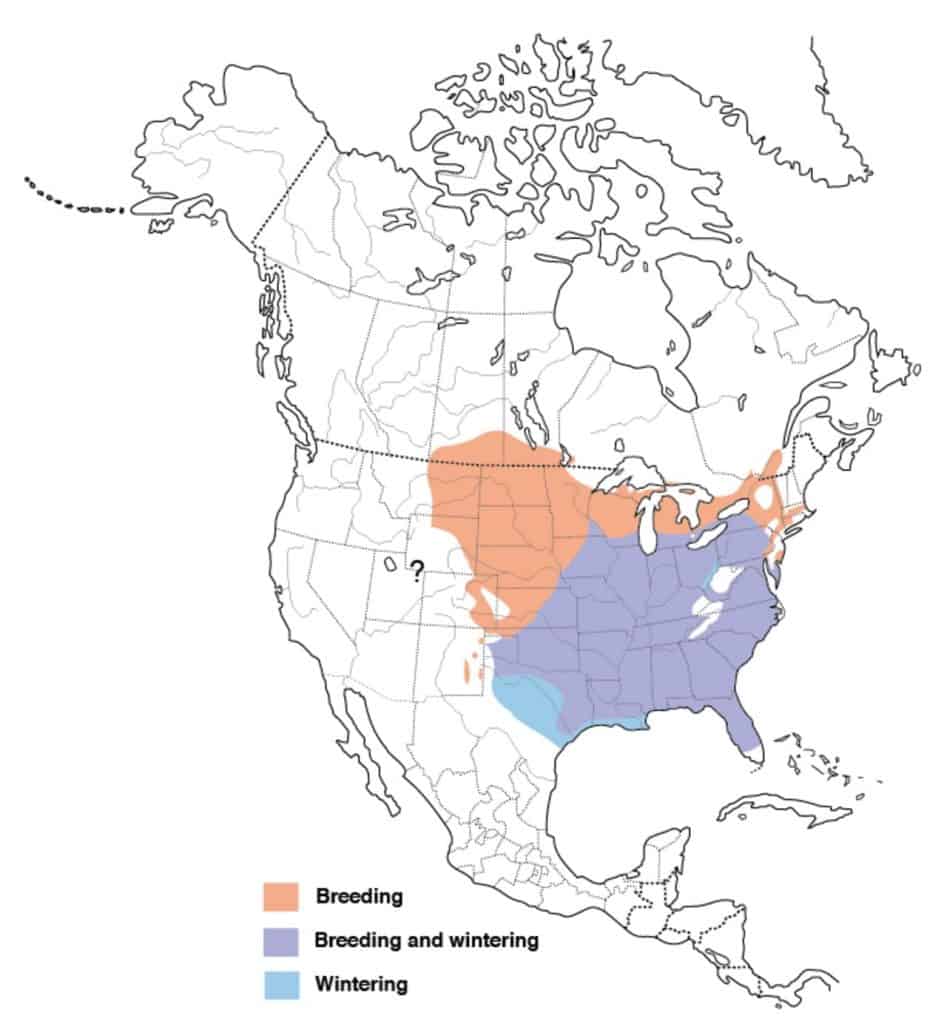
Scarlet Tanager
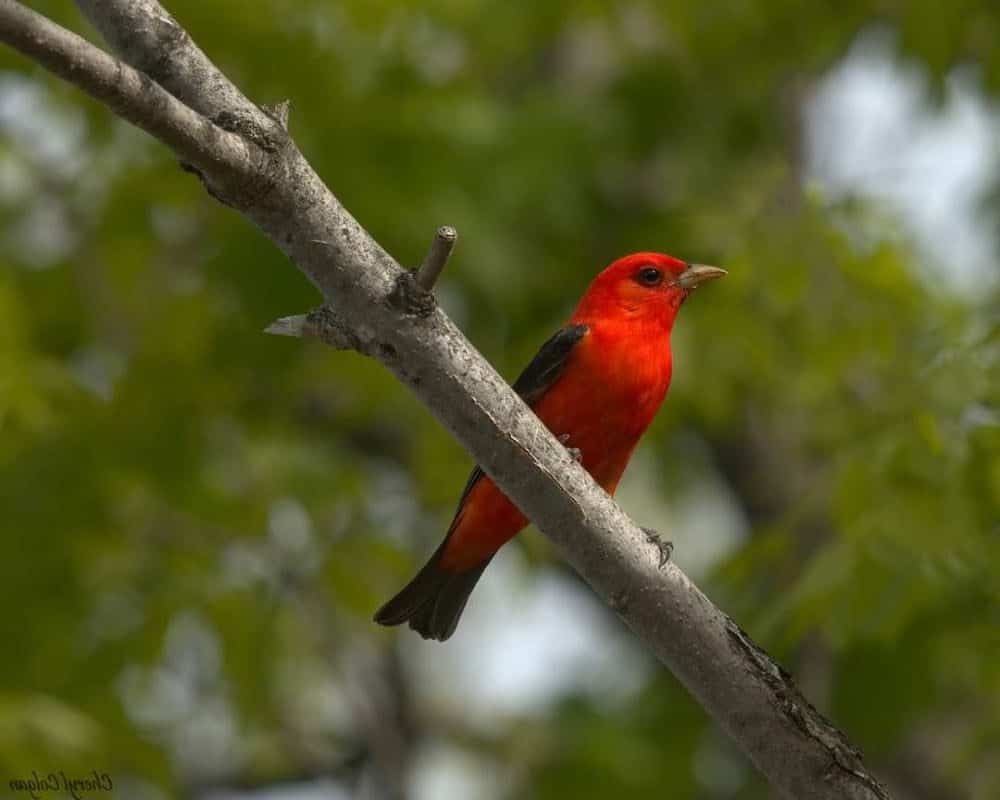
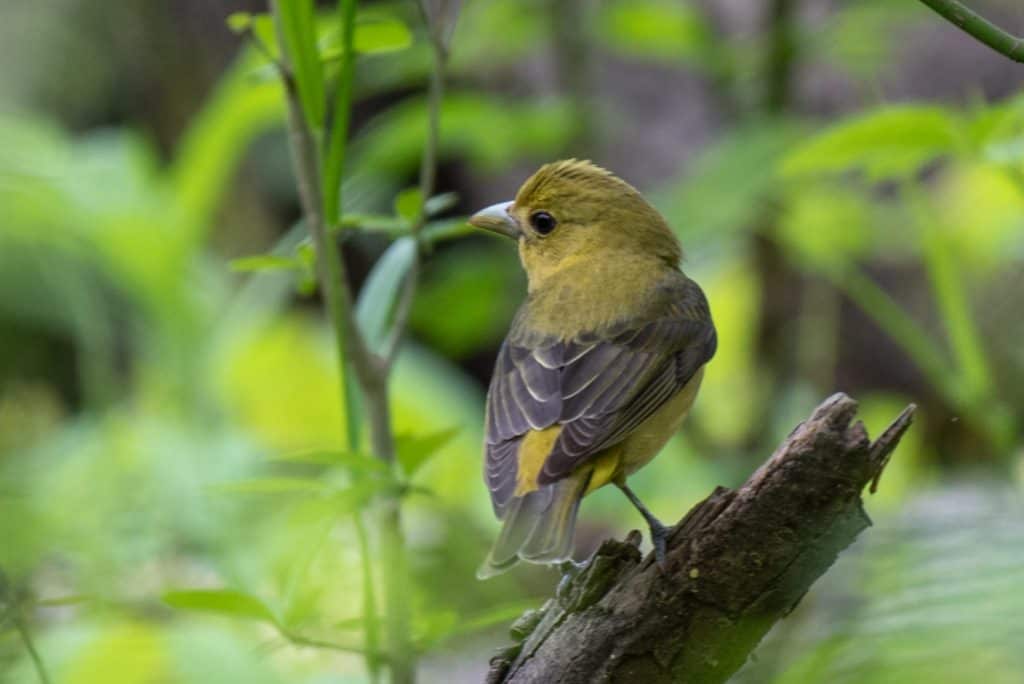
Appearance: Scarlet tanagers are small birds about 6.5″ long, with vibrant red faces and bodies (although many consider them to be a deep shade of orange), tan beaks, black wings, and short black tails. No crown. The female scarlet tanager (and juveniles) are the same except yellow instead of red.
Diet: Insects in summer; fruit in fall/winter.
Feeder food: Scarlet tanagers are unlikely to visit feeders. However, you can attract them by planting berry-producing plants such as blackberries, raspberries, huckleberries, juneberries, serviceberries, mulberries, and strawberries.
Habitat: Thickly forested regions in the eastern US. Often spotted high in the treetops.
Nesting: A loosely constructed nest of grass, twigs, bark strips, pine needs, and other plant materials. The nest rests high in a deciduous tree out in the middle of a horizontal branch about 50′ up. 1 brood/season, 3-5 eggs/brood, eggs are green/blue with multicolored and shaded marks of brown, purple/red. Incubation is 12-14 days and the young fledge is between 9-15 days.
Migration: Scarlet tanagers are migrators. In the spring, they migrate north to breed and raise their young. In the fall, they migrate south for the winter.
Breeding range: Primarily the eastern half of the US (except Florida and Louisiana), as well as the southern part of Canada’s Manitoba, Saskatchewan, and Ontario.
Winter range: South America.
Range Map
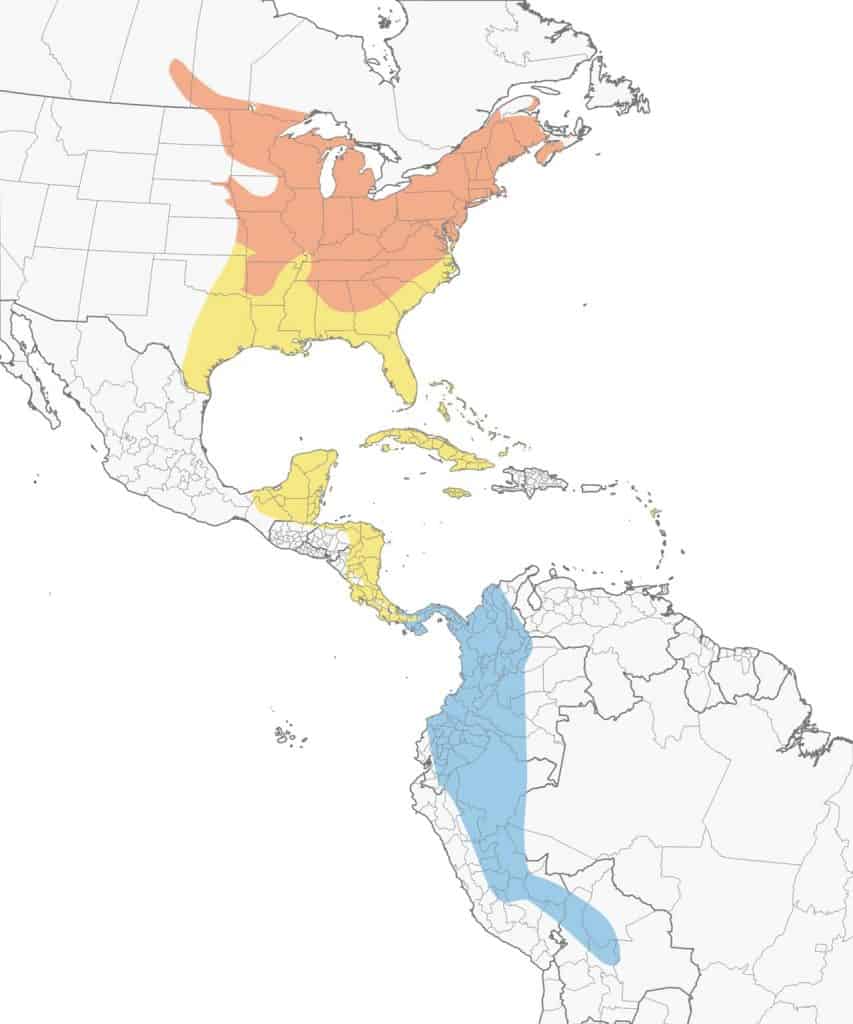
Summer Tanager
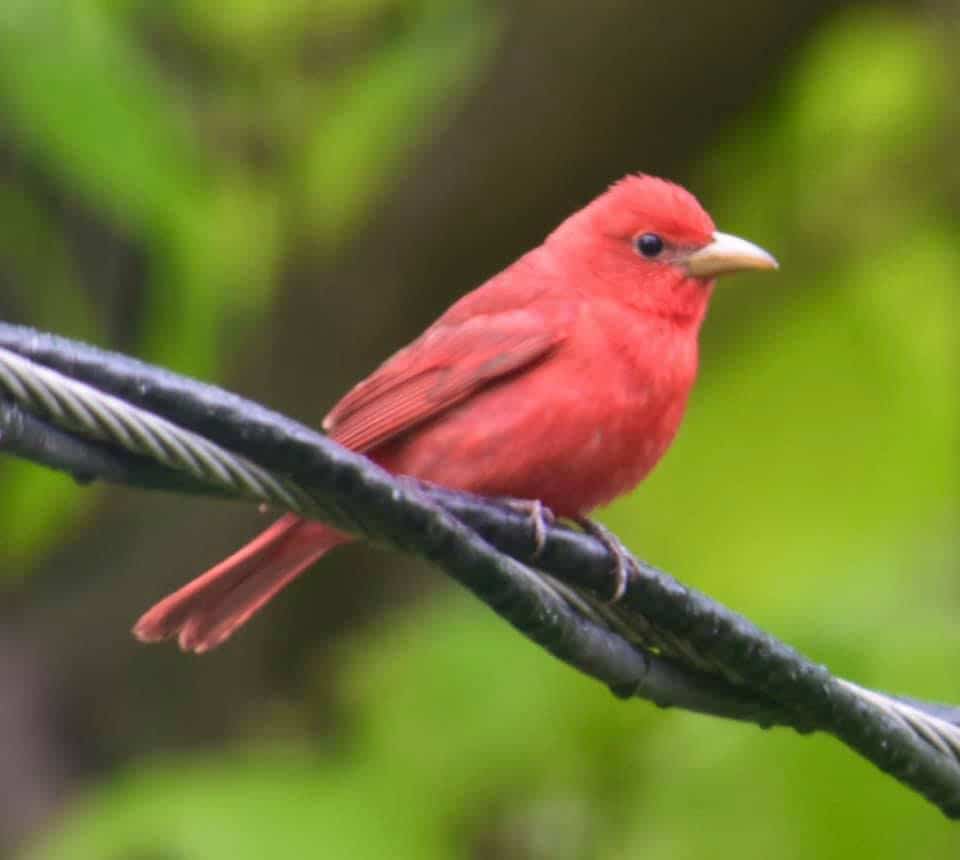
Appearance: The summer tanager is a small bird about 6.5-7″ long, with bright red all over, a long tan beak, a medium-length tail, and no crown. Female and juvenile are yellow.
Diet: Insects, especially bees and wasps. Also dine on spiders, cicadas, beetles, ants, and termites. Fruit including mulberries, pokeweed, citrus, and bananas.
Feeder food: Unlikely to visit a feeder. However, they can be enticed by planting berry trees and shrubs – especially near a forested area.
Habitat: Open forested areas that contain deciduous & pine trees throughout much of south-central and southeastern US.
Nesting: The nest is constructed primarily from dried grasses and herbs into a small cavity and often placed at the fork of tree branches. 1-2 broods/season, 3-4 eggs/brood, incubation is 11-12 days and the young fledge after about 8-12 days. Eggs are pale blue/green with brown spots.
Migration: Summer tanagers are migrators. In the spring they migrate north to breed and raise their young. Then in the fall, they migrate back south for the winter.
Breeding range: Midwest and southern US states including California, Nevada, Arizona, New Mexico, Texas, Oklahoma, Kansas, Iowa, Missouri, Nebraska, Louisiana, Illinois, Indiana, Ohio, Kentucky, Tennessee, Mississippi, Georgia, Alabama, Florida, South Carolina, North Carolina, Virginia, and Pennsylvania.
Winter range: Mexico, the Caribbean islands, Central America, and South America.
Range Map
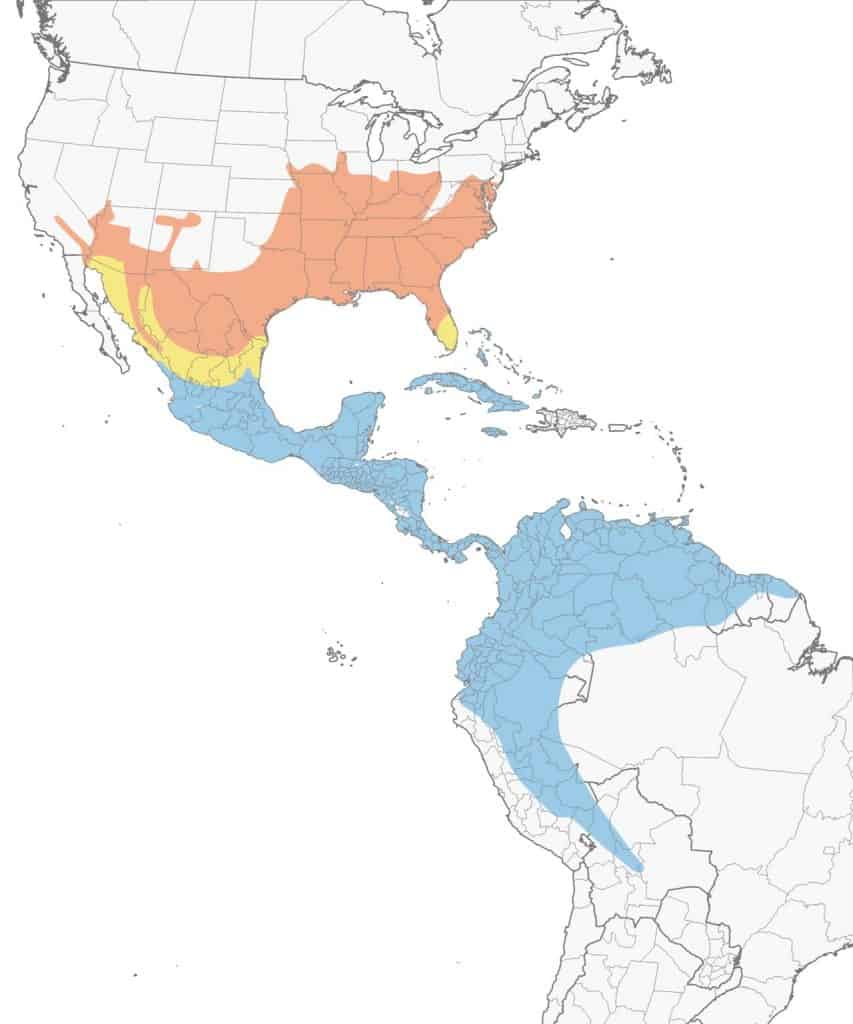
Vermilion Flycatcher
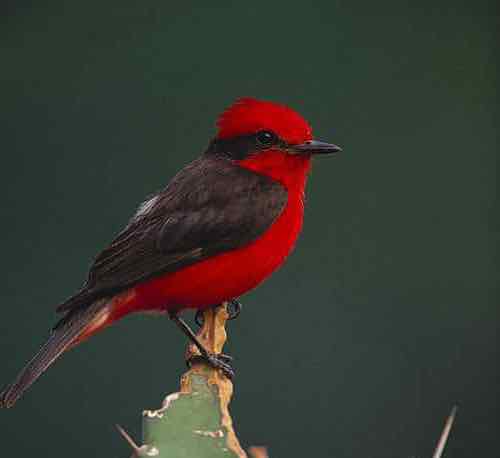
| Appearance | Small bird about 5″ long. Bright red-orange with brown back, feathers, tail, and a mask over each eye. Flathead and stocky chest with a dark brown pointy bill. Females are gray/brown with a white breast and rust-colored lower belly. |
| Diet | Flying insects are their favorite. They also dine on grasshoppers and butterflies, honeybees, beetles, and crickets. |
| Feeder Food | You may be able to entice them with mealworms. |
| Habitat | Primarily live in the far southwest in the scrubby desert, wooded areas near riverbanks and lowlands with shrubs. |
| Nesting | Small nest constructed of twigs, grass, and spiderwebs located about 10-20′ up in a tree in the fork of a branch. 1-2 broods/season, 2-4 eggs/brood, incubation is 13-15 days and the young fledge about 14-16 days. Eggs are white with light and dark spots. |
Range Map
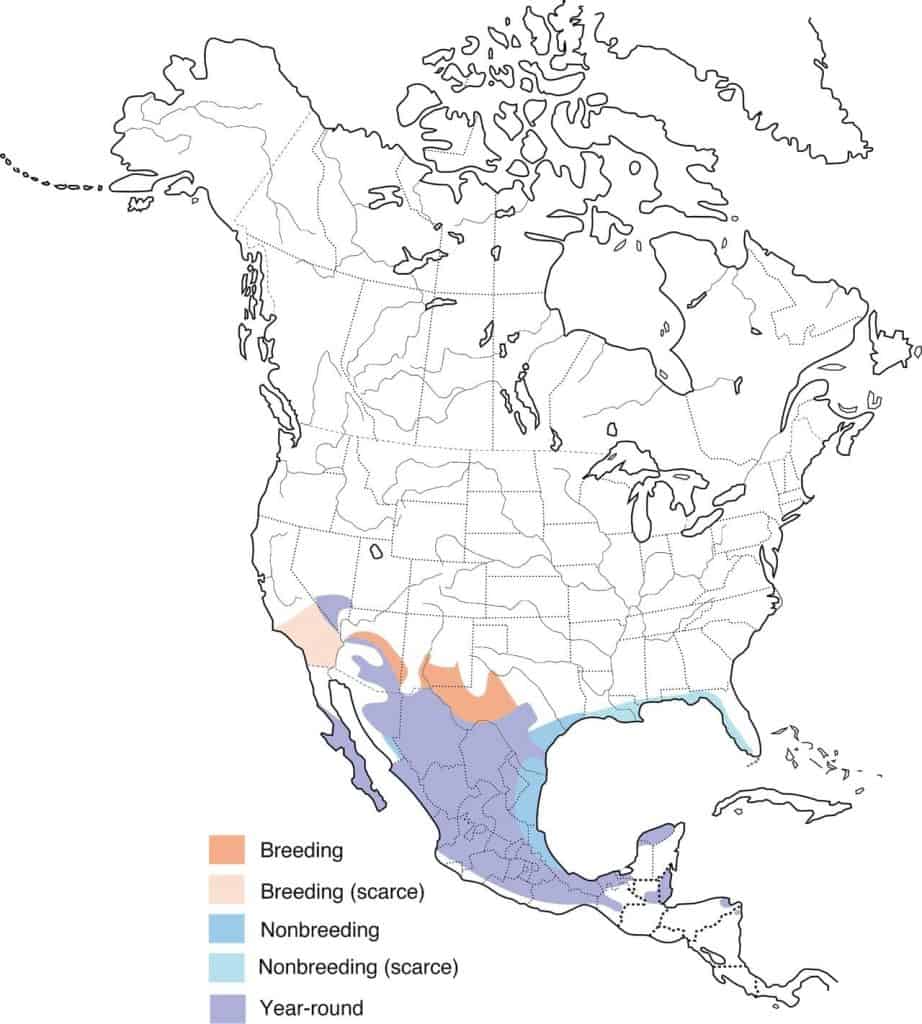
Western Tanager
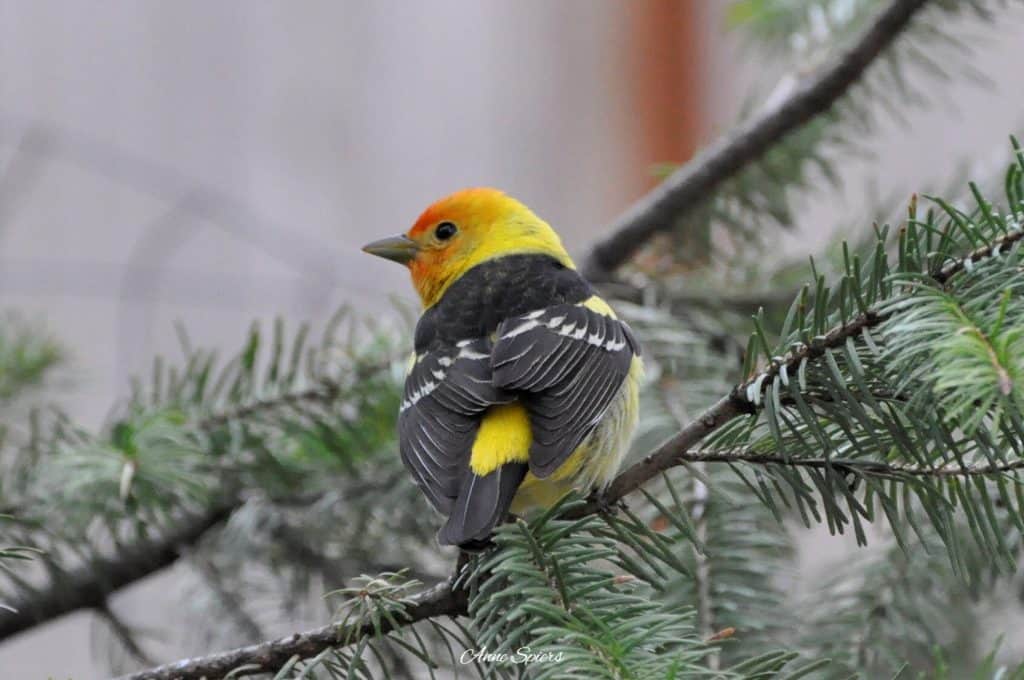
Appearance: The western tanager is a medium-sized bird about 7 1/4″ long with a bright red-orange head, black-and-yellow wings, and bright yellow chest. The female does not have a red-orange head. Instead, she’s an olive-yellow color throughout.
Diet: Insects and occasionally fruits and berries.
Feeder food: Western tanagers are unlikely feeder visitors but may be enticed with fruit or grape jelly.
Habitat: Open woodlands, especially when pine, oak, and conifers are present. Higher elevations are preferred.
Nesting: The cup-shaped nest is placed high in a conifer tree, up to 60′ up. They have 4 eggs/brood and incubate for about 13-14 days.
Migration: Western tanagers are migrators. In the spring they head north into Canada’s Yukon Territory, British Columbia, Alberta, and Saskatchewan as well as the U.S. states Washington, Idaho, Montana, Oregon, Wyoming, California, Nevada, Utah, Colorado, Arizona, and New Mexico. In the fall, they head back south to winter in Mexico.
Range Map
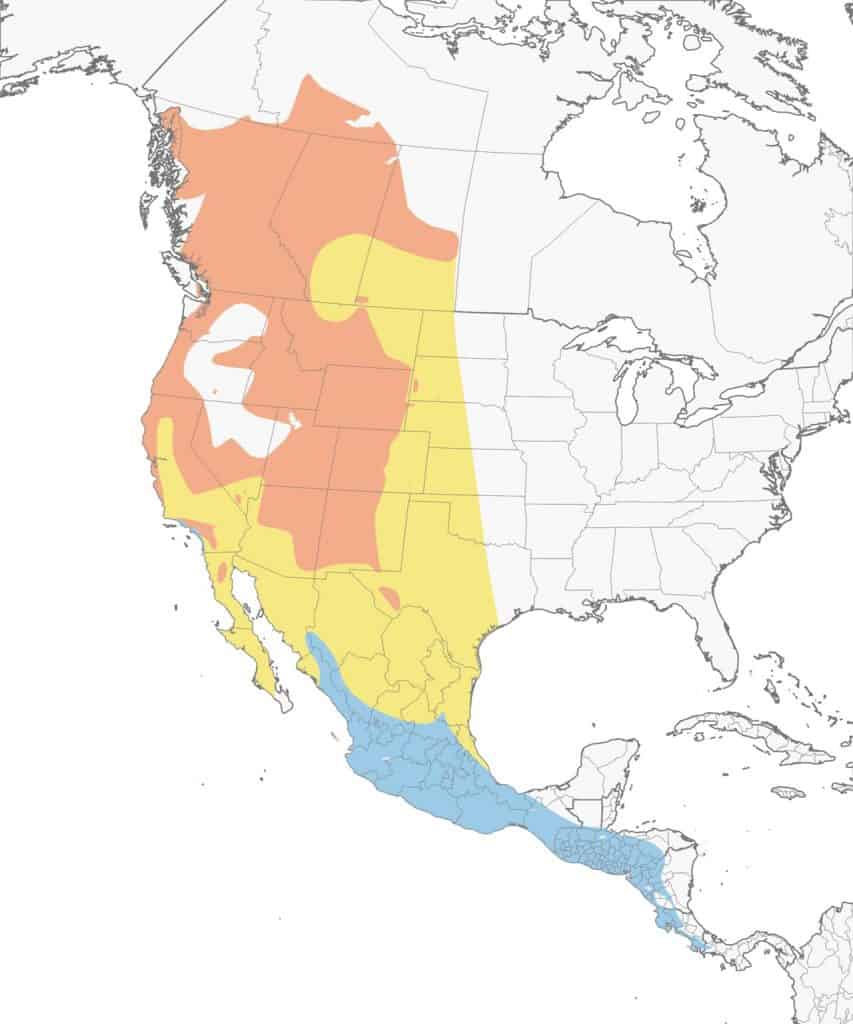
Birds with a Partial Red Head
Acorn Woodpecker
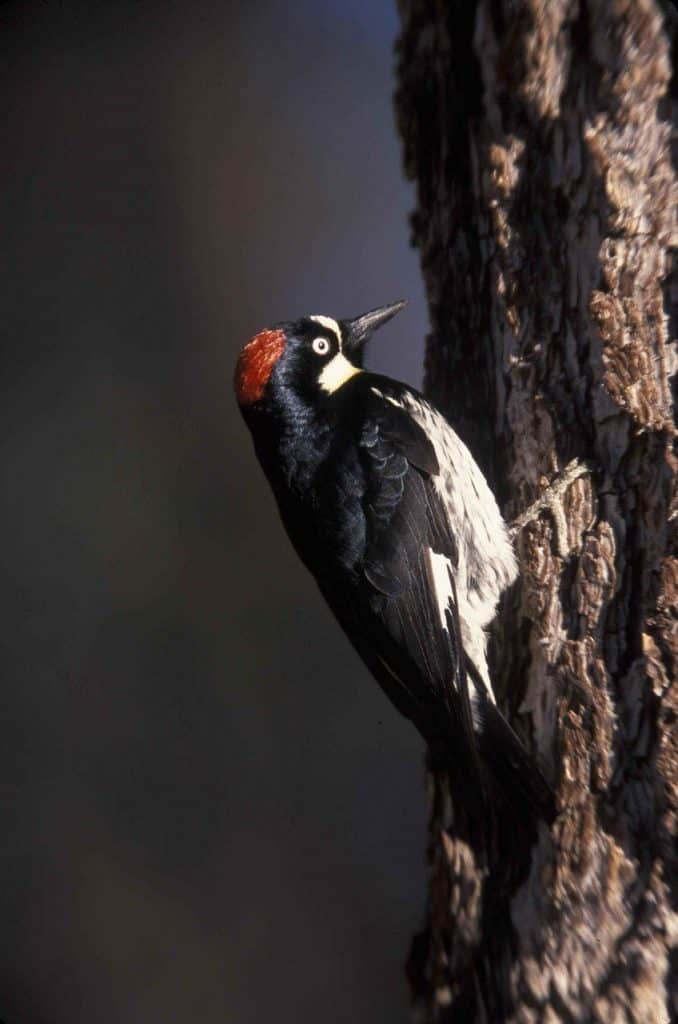
Appearance: Acorn woodpeckers are large birds about 9″ long. Their bold colors consist of red, white, and black on the head and black wings with white wing patches. A red crown is surrounded by a white forehead. The female looks the same except with a red crown with a black band in front instead of all red.
Diet: Insects (especially ants) and nuts (especially acorns). Acorn woodpeckers are known for constructing elaborate storage “granaries” to maintain a supply of acorns mainly for winter consumption.
Feeder food: Suet and peanuts.
Habitat: Woodlands with oak trees as well as mixed oak and conifers. Large trees are used as “granaries” to store the incredible amount of acorns that groups of Acorn woodpeckers collected.
Nesting: Acorn woodpeckers are cavity nesters. They have 3-8 eggs/brood and incubate for about 11 days.
Migration: Acorn woodpeckers do not migrate. They typically remain in their year-round range all seasons of the year. Being a rather sedentary species, they prefer to remain within their year-round range, however, after the breeding season if food supplies diminish they will wander to the outer edges of their range (or just outside it) until they find a supply of acorns. The distance of this movement varies from one season to the next and is dependent on the food supply.
Year-round range: Along the pacific coasts of Oregon and California, central Arizona & New Mexico as well as southwestern Texas and inland Mexico.
Range Map
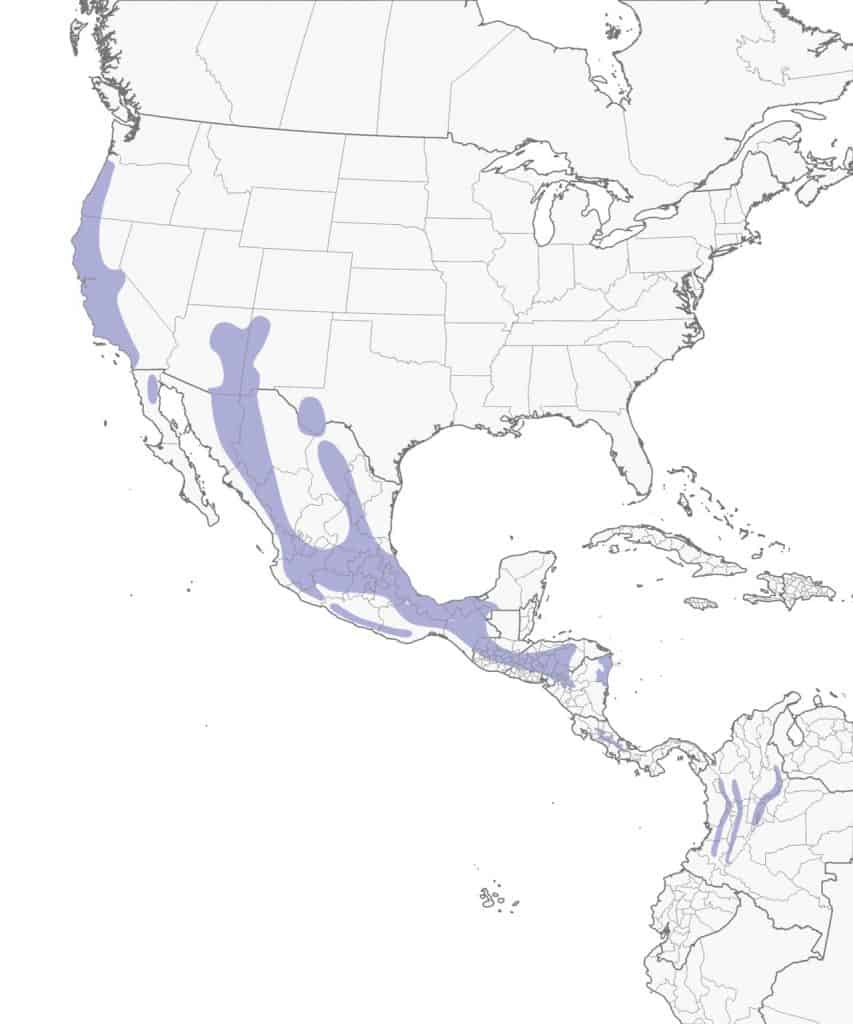
Arizona Woodpecker
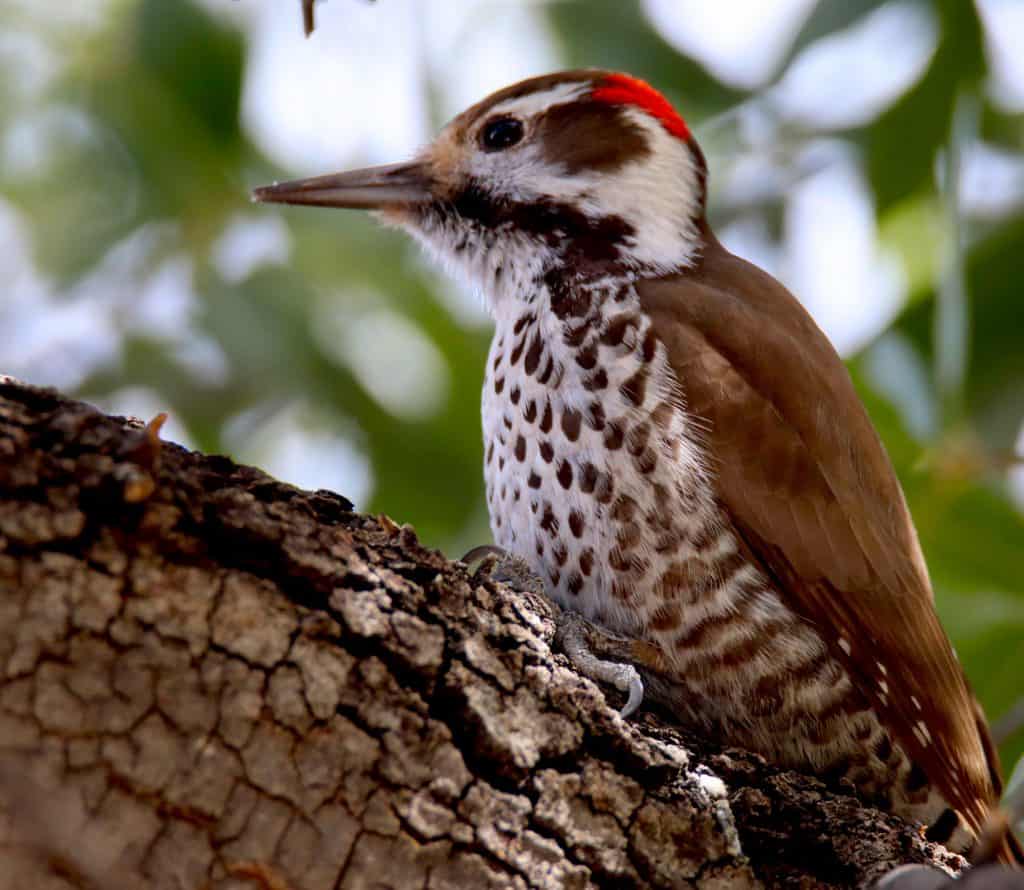
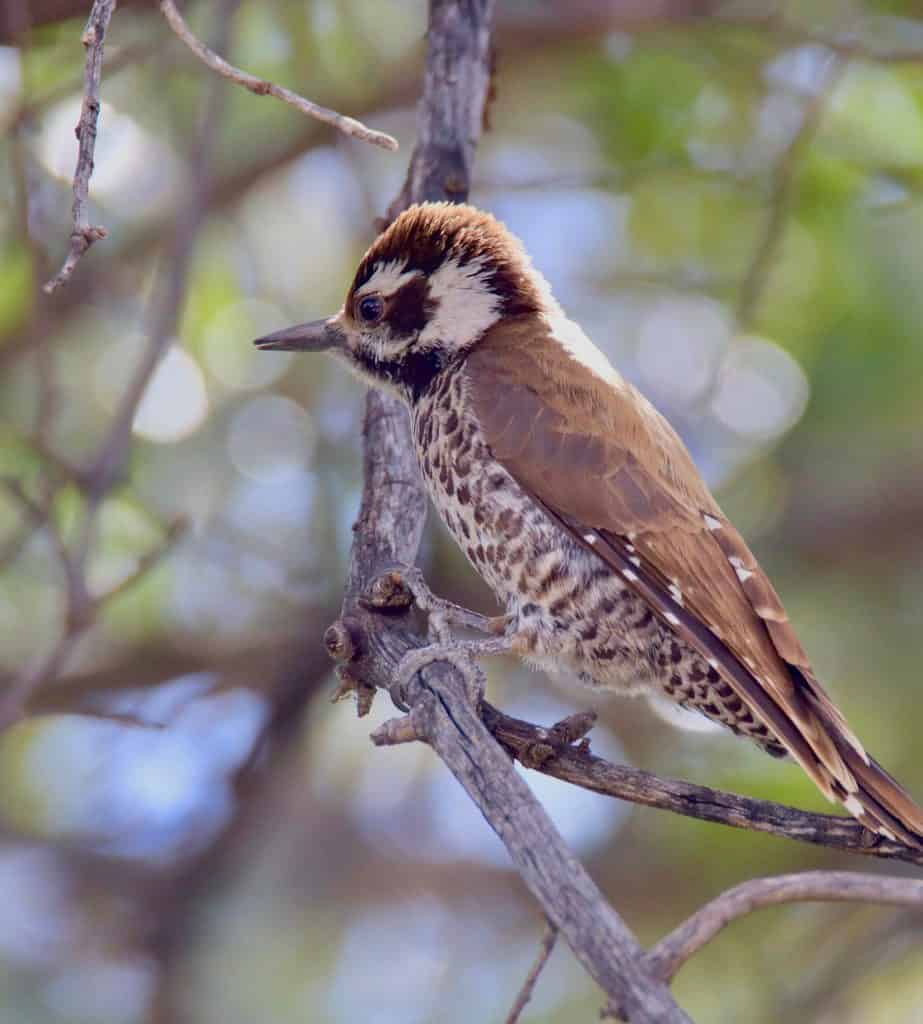
| Appearance | The Arizona woodpecker is a medium-sized bird about 7-8″ long and predominantly a dusty brown color. The belly is white and brown spotted, the head has a brown crown in front and red behind, a brown spot behind each eye, a brown streak across its lower neck, long pointy bill. The female is the same except her crown is all brown, no red. |
| Diet | Insects, especially beetle larvae. They also eat ants, fruits, and acorns. |
| Feeder Food | Unlikely to visit a feeder. |
| Habitat | Found only in southern Arizona, southwestern New Mexico, and Mexico, they prefer wooded areas. |
| Nesting | They’re cavity nesters and have 2-3 eggs/brood. They’re asynchronously so the chicks from a given brood are of different ages and sizes. |
Range Map

Cassin’s Finch
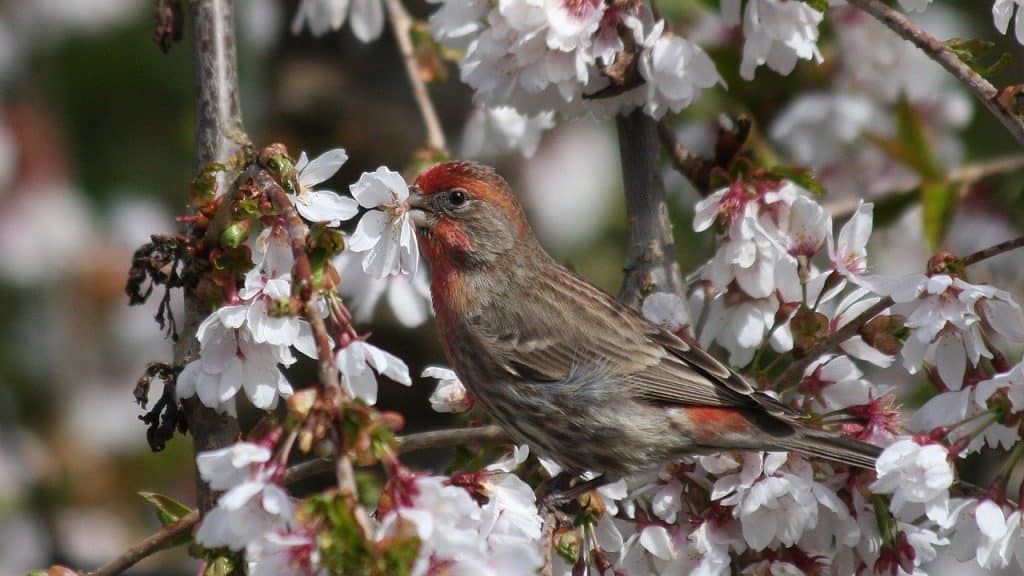
| Appearance | The Cassin’s finch is a small bird about 6 1/4″ long. They’re brown with a red cap, brown stripe across their cheeks, and white underneath with light pink streaks on the chest. The female is similar except she doesn’t have red or pink. her chest and belly are heavily streaked brown and she has a white streak above and over her eyes. |
| Diet | Seeds, buds, and berries. Occasionally insects. |
| Feeder Food | Black-oil sunflower seeds. |
| Habitat | Open forested areas rich with conifers. |
| Nesting | Nest: They build a nest high up in a conifer – about 30+ feet up. Broods: 4-5 eggs/brood Clutch: 3-6 eggs/brood Egg color: Light bluish with black, brown, and purplish speckles Egg size: 0.7 – 0.8 inches by 0.5 – 0.6 inches Incubation: 12-14 days. |
Range Map
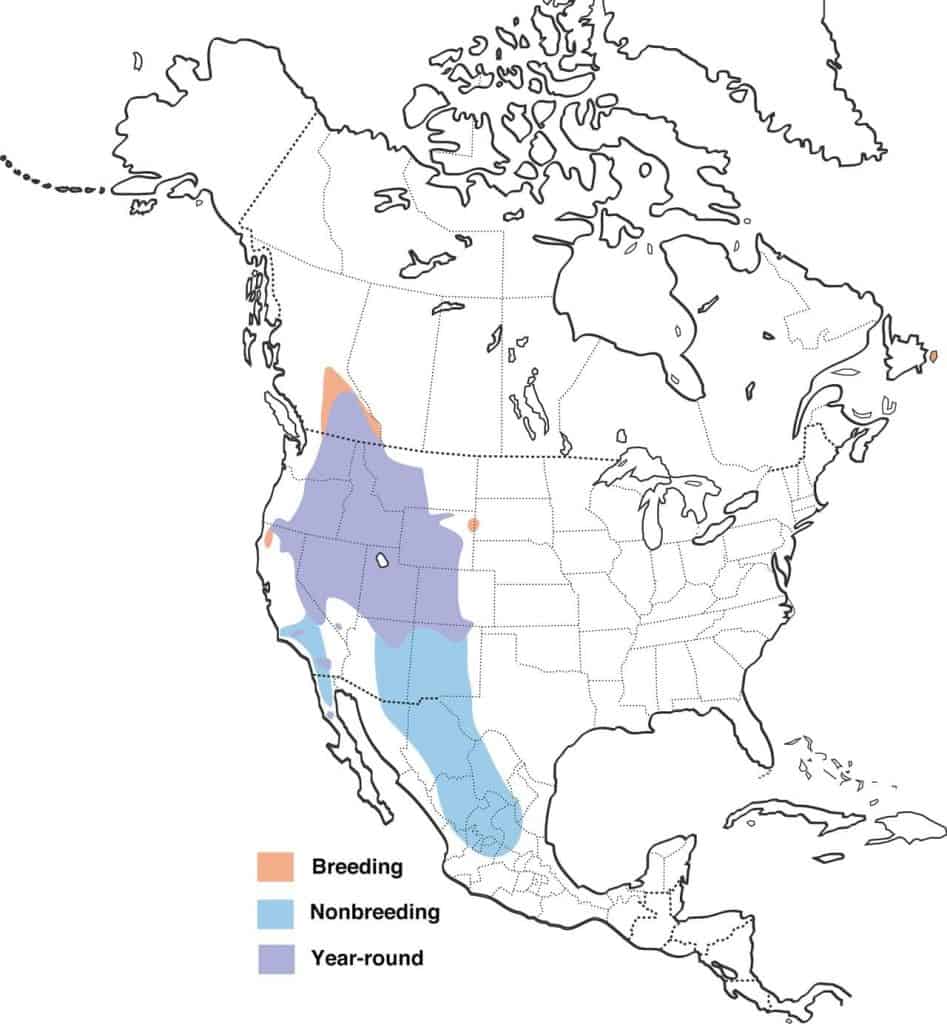
Common Redpoll
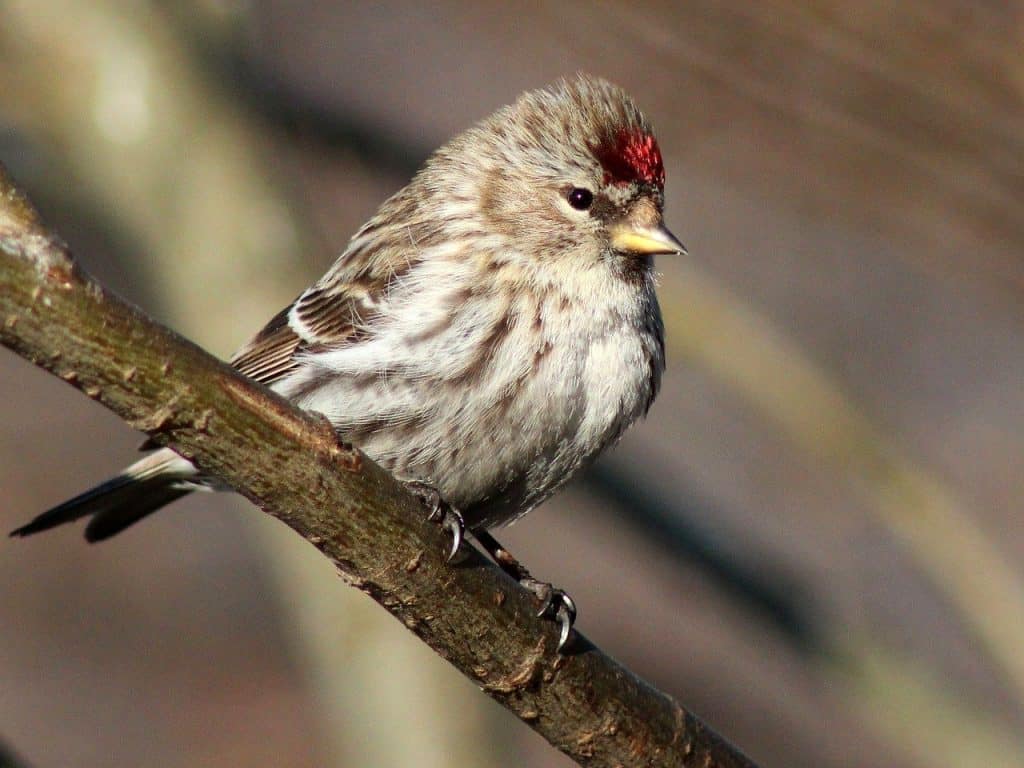
| Appearance | The common redpoll is a small bird about 5″ long. It’s a heavily streaked bird with a bright red crown, a black spot beneath the chin, and raspberry splotch on its chest. The female is similar except without the raspberry chest. |
| Diet | Seeds, insects. |
| Feeder Food | Black-oil sunflower seed, hulled sunflower seed, and nyjer. |
| Habitat | Open areas lined with trees. |
| Nesting | Cup-shaped nest. They have 1 brood/season and 4-5 eggs/brood that are pale green with purple markings. |
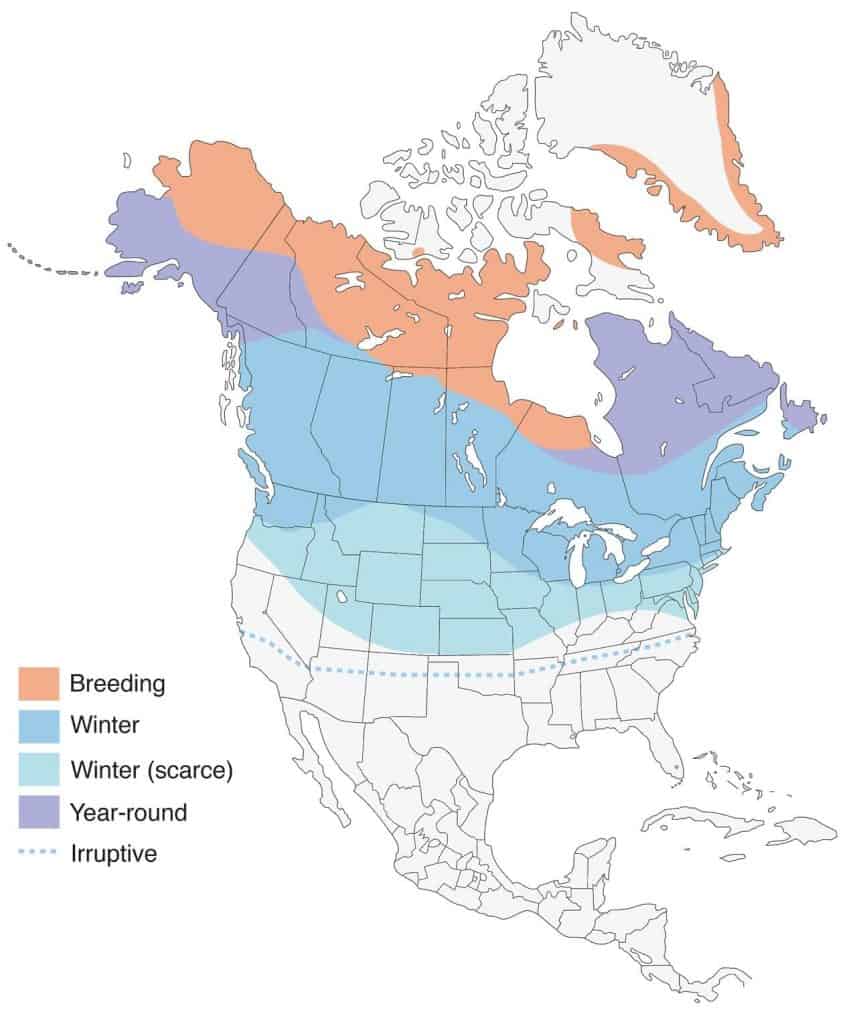
Range Map
Downy Woodpecker

Appearance: Downy woodpeckers are small birds 6″ – 7″ long. Males are tuxedo-black with a white stripe on the back, white belly, white outer tail feathers, some spotted areas of white on the wings, a yellow/tan spot above the beak, and the infamous red patch on his head at the back of the crown. Females are nearly identical without red coloring.
Diet: Insects, and fruit from trees/shrubs.
Feeder food: Suet, peanut butter spread, Sunflower seeds, Safflower seeds, hulled peanuts, corn, fruits, nectar (sugar water).
Habitat: Anywhere there are trees.
Nesting: Downy woodpeckers nest in cavities – either a hole in a tree trunk or a nesting box. Usually only one brood per season, 3-6 all-white eggs. Incubation is about 11-12 days.
Migration: Downy woodpeckers are not migrators. They remain in their year-round range all four seasons.
Year-round range: Every US state and Canadian province (except Nunavut).
Range Map
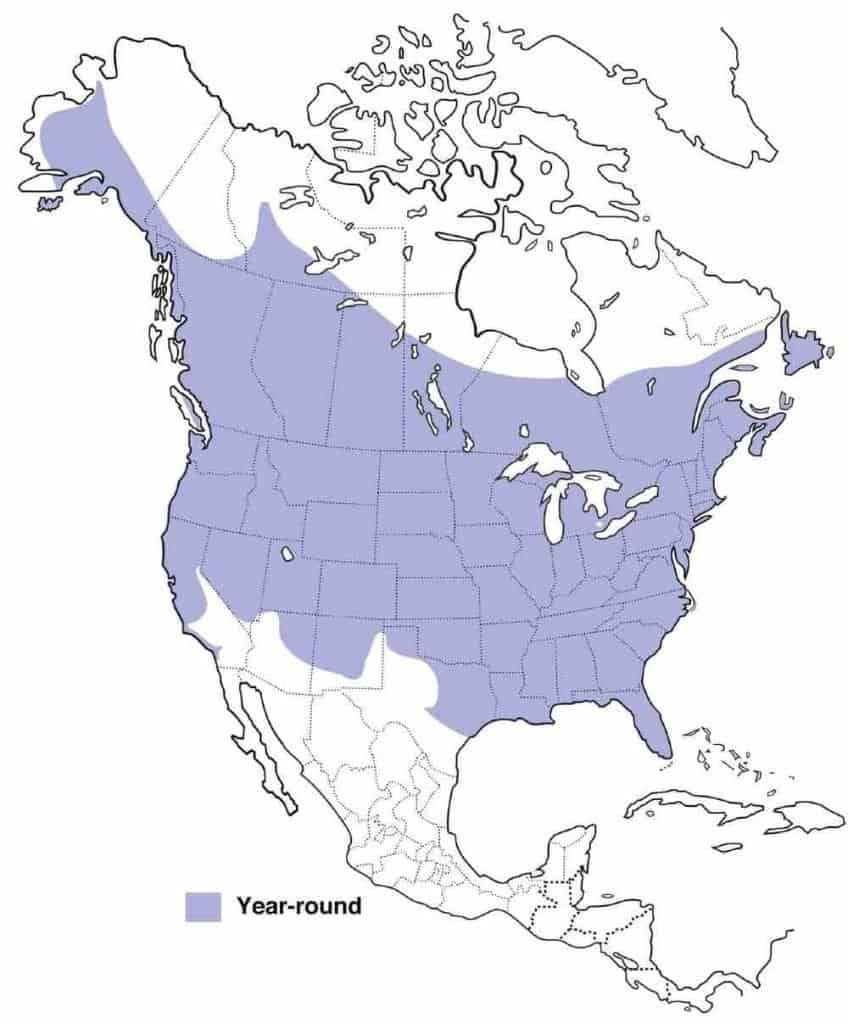
Gila Woodpecker
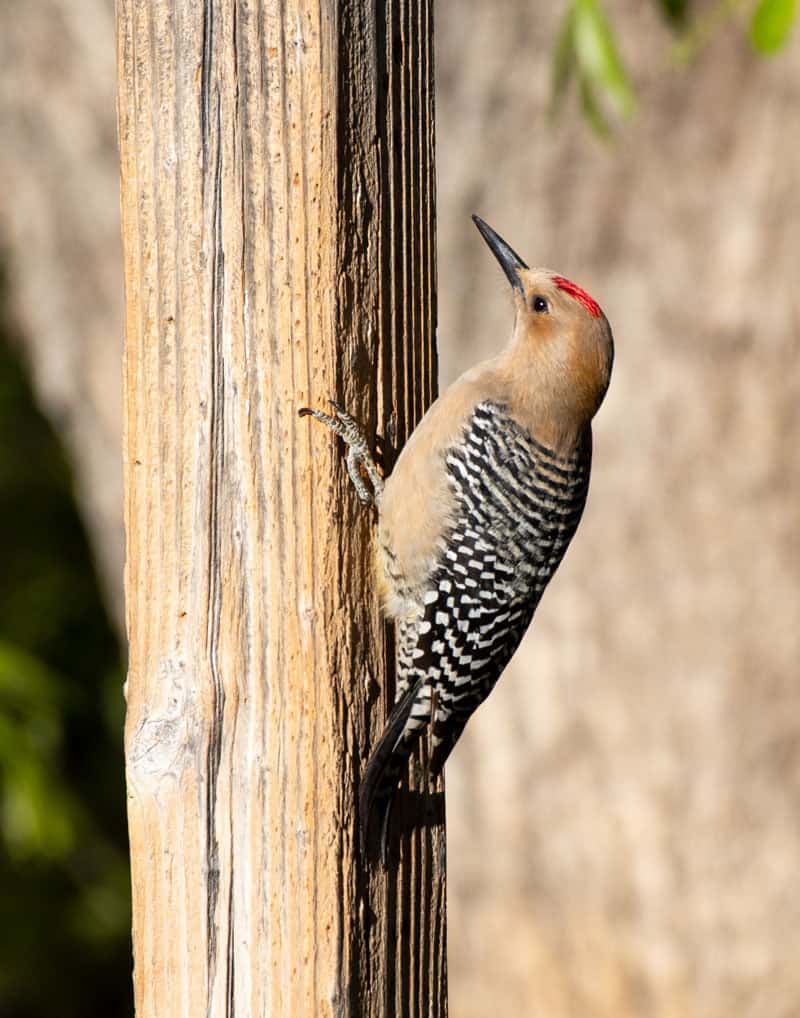
| Appearance | The Gila woodpecker is a large bird about 8-10″ long. They are pale gray with a zebra pattern on the back, wings, and tail, a yellow patch on their lower belly, a red stripe on their crown, and a long pointy bill. The female is similar without the red spot on the head. |
| Diet | These birds have a varied diet including Insects (especially cicadas, ants, beetles, grasshoppers), beef and pork animal meat (especially bacon rind), earthworms, small lizards, eggs and young of songbirds, fruits, and cultivated pecans. |
| Feeder Food | Suet and nectar. |
| Habitat | Gila woodpeckers primarily live in the Sonoran Desert of California, Arizona, New Mexico, and Mexico. |
| Nesting | Gila woodpeckers are cavity nesters, typically within an excavated Saguaro cactus. They often have 3 broods/season. |
Range Map
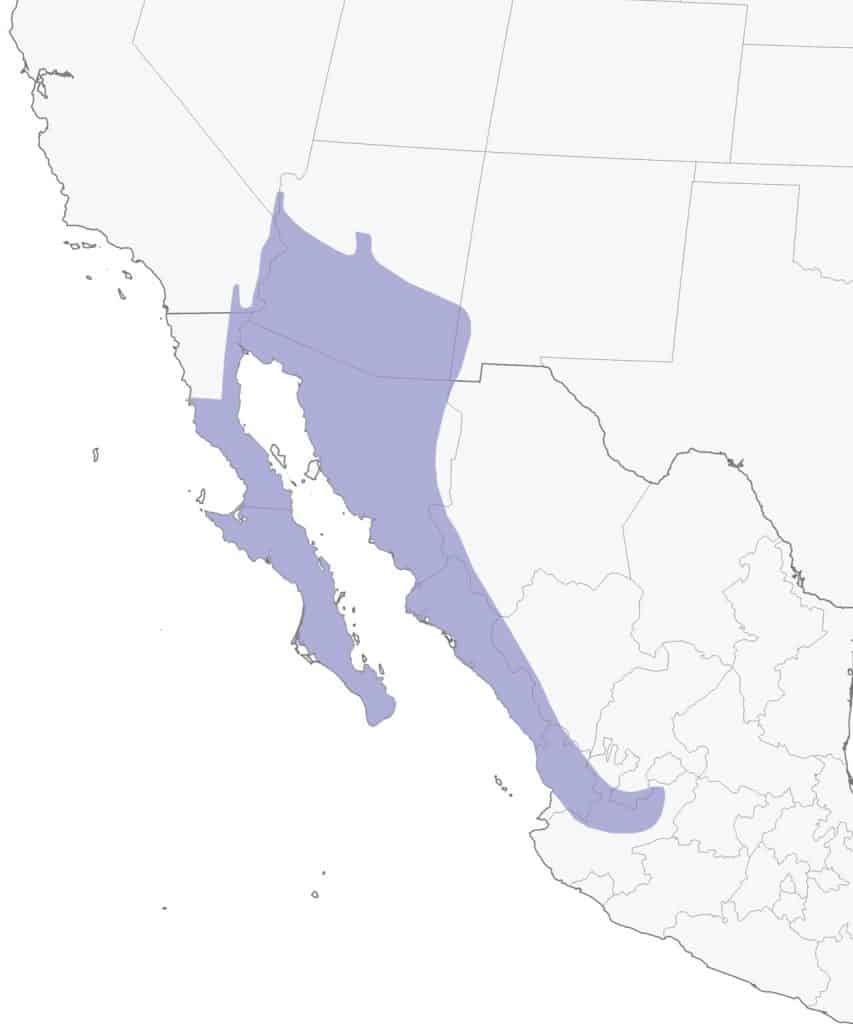
Hairy Woodpecker
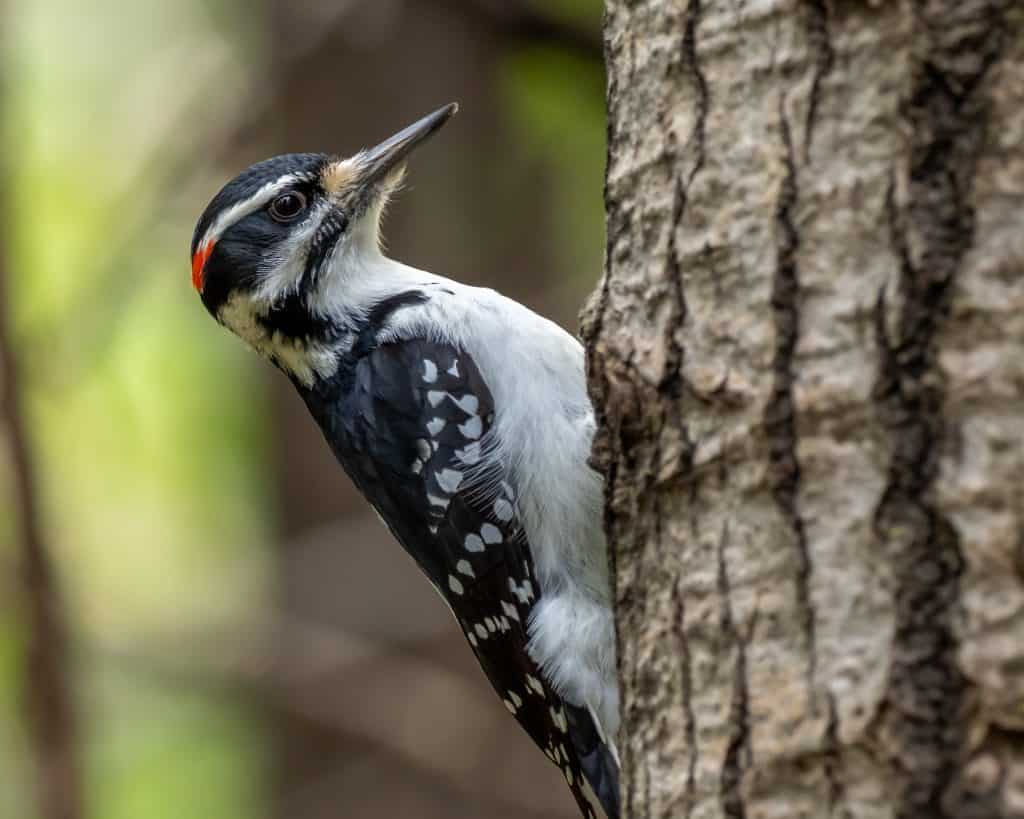
Appearance: A medium-sized black-and-white bird about 9″ long with a white belly, and black wings with white spots. A white stripe runs down the back. They have a red mark on the back of the head and a long black bill. The Female is the same except with no red mar
Diet: Insects, seeds, nuts.
Feeder food: Suet, hulled peanuts.
Habitat: Mature forested areas, urban and suburban areas where dense trees are found.
Nesting: They are cavity nesters generally excavating their own holes. They have 1 brood/year, and 3-6 white eggs per brood. Incubation is 11-15 days.
Migration: Hairy woodpeckers are not migrators. They remain in their year-round range all seasons of the year.
Year-round range: All US states, every Canadian province except Nunavut, Mexico, and Central America.
Range Map
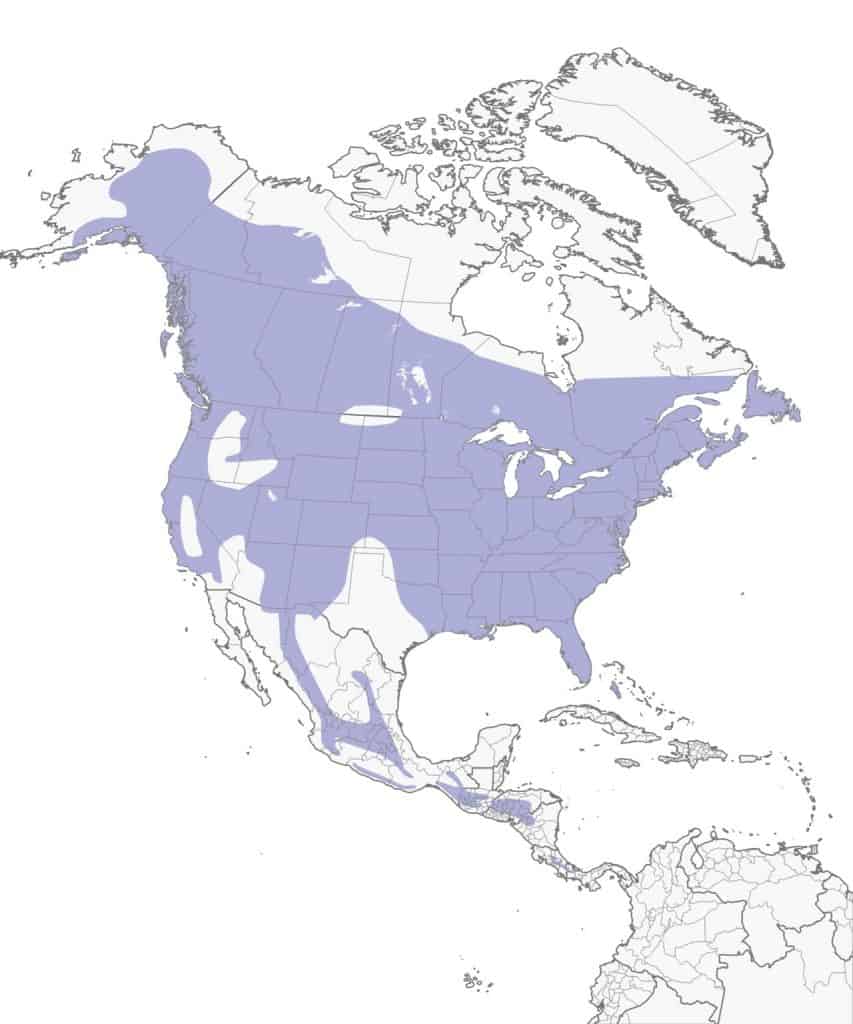
Northern Flicker
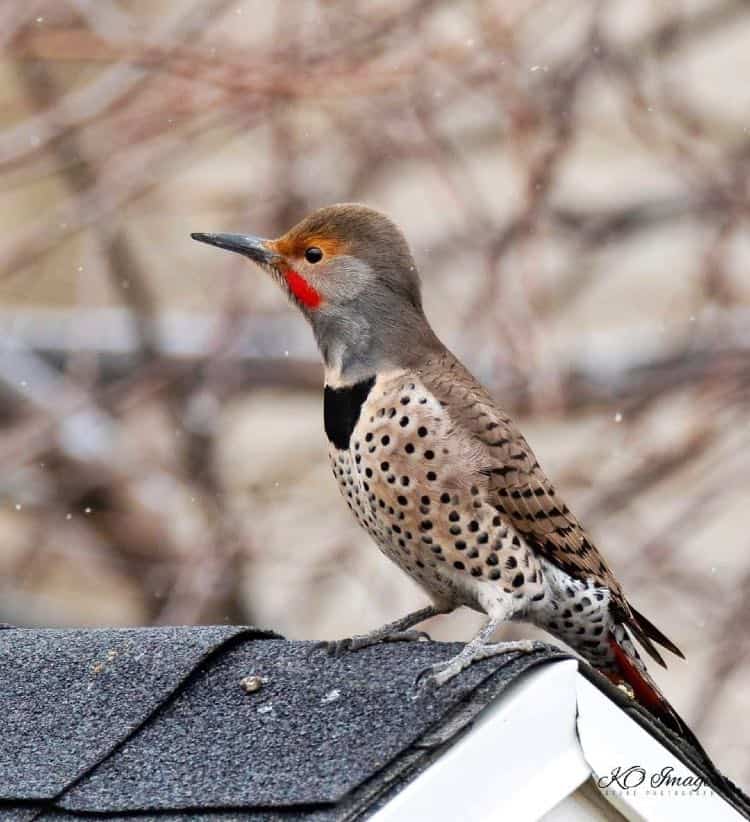
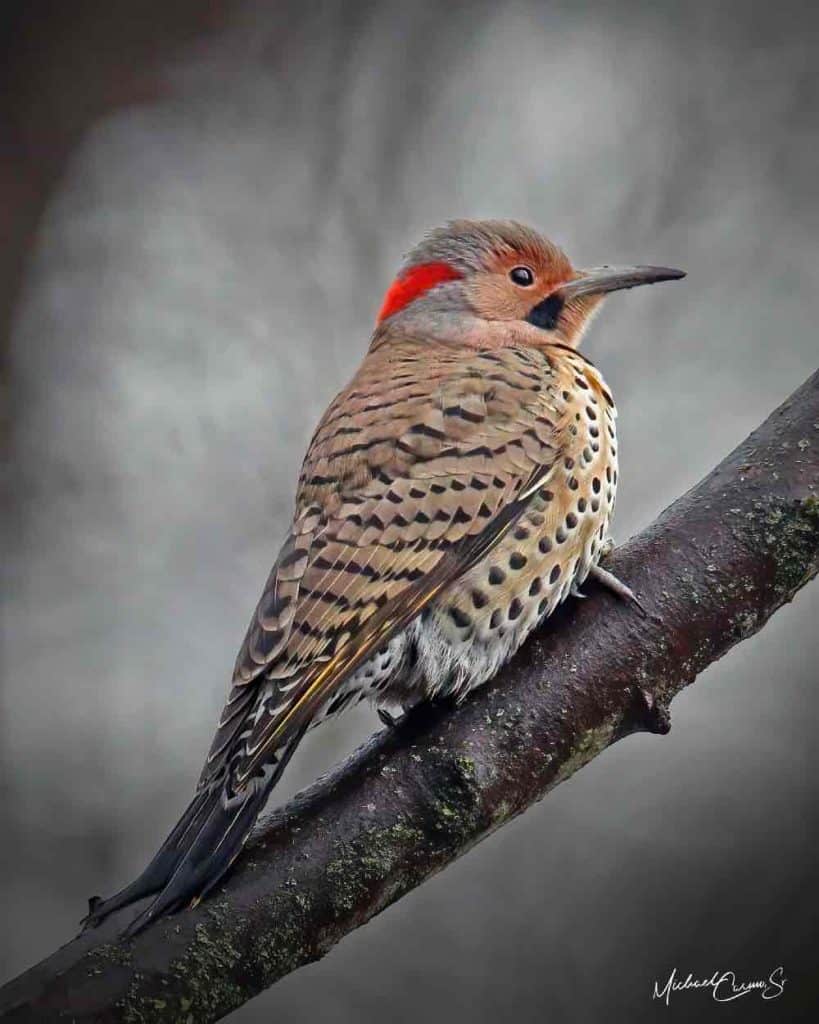
Appearance: A large bird about 12.5″ long. They have brown backs with black bars, a black crescent on the upper chest, and white with black spots on the belly and underparts.
• In the eastern part of their range, they are referred to as “yellow-shafted northern flickers” and have bright yellow underwings and undertail. They have a gray crown, tan face, and a red patch on the nape. The male has a black swipe on his cheek, the female does not.
• In the western part of their range, they are referred to as “red-shafted northern flickers” and have pink underwings and undertail, brown crown, gray face, and crown & nape are brown. The male has a red swipe on his cheek, the female does not
Diet: Insects, especially ants.
Feeder food: Hulled peanuts and suet.
Habitat: Open areas near trees.
Nesting: They are cavity nesters and have 1 brood/year. 5-8 white unmarked eggs per brood. Incubation is 11-14 days.
Migration: Northern flickers are migrators. Scientists believe the timing and duration of their migration from the breeding range to their winter range are dependent on weather. They generally migrate at night and travel in large but loose flocks of up to 100 or so birds.
Year-round range: Each US state as well as parts of British Columbia,
Breeding range: Alaska, Canada, and inland parts of their year-round range in Washington, Oregon, and California.
Winter range: Many will winter in the year-round range while others head further south into southeast California, southwest Arizona, Texas, and Mexico.
Range Map
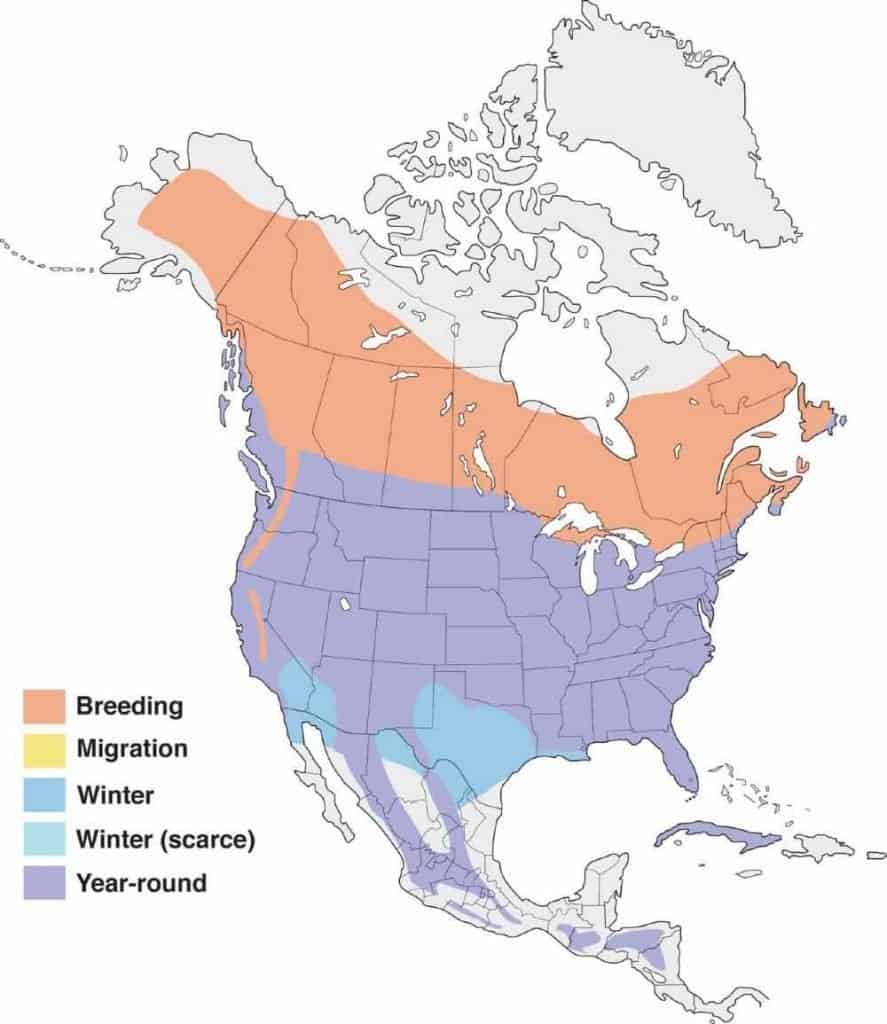
Nuttall’s Woodpecker
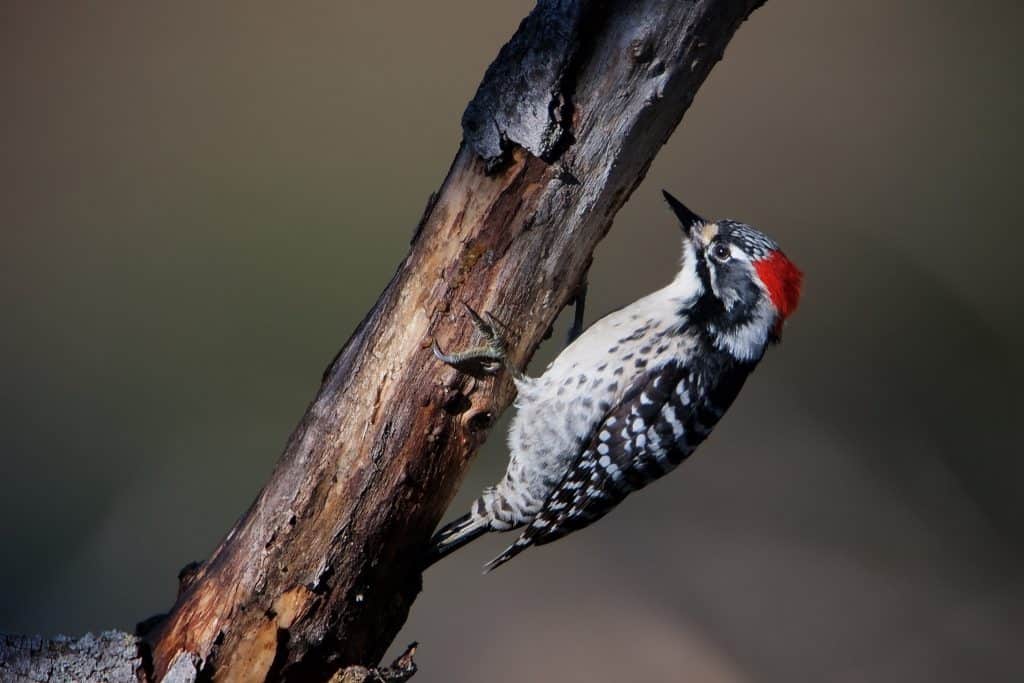
| Appearance | The Nuttall’s woodpecker is a medium-sized bird about 7 1/2″ long. They’re black-and-white with a red spot on the rear of their crown, white belly, black face with white borders, and a black bar at the base of their neck. The female is the same except she has a black crown instead of red. |
| Diet | Insects and occasionally acorns, seeds, and fruit. |
| Feeder Food | Suet and sunflower seeds. |
| Habitat | They’re found only in California near Baja California. |
| Nesting | Nuttall’s woodpeckers are cavity nesters. They’ll nest in a tree hole, the hole of a post/pole, or a manmade nesting box. They have 3-6 eggs/brood and incubate for about 14 days. |
Range Map
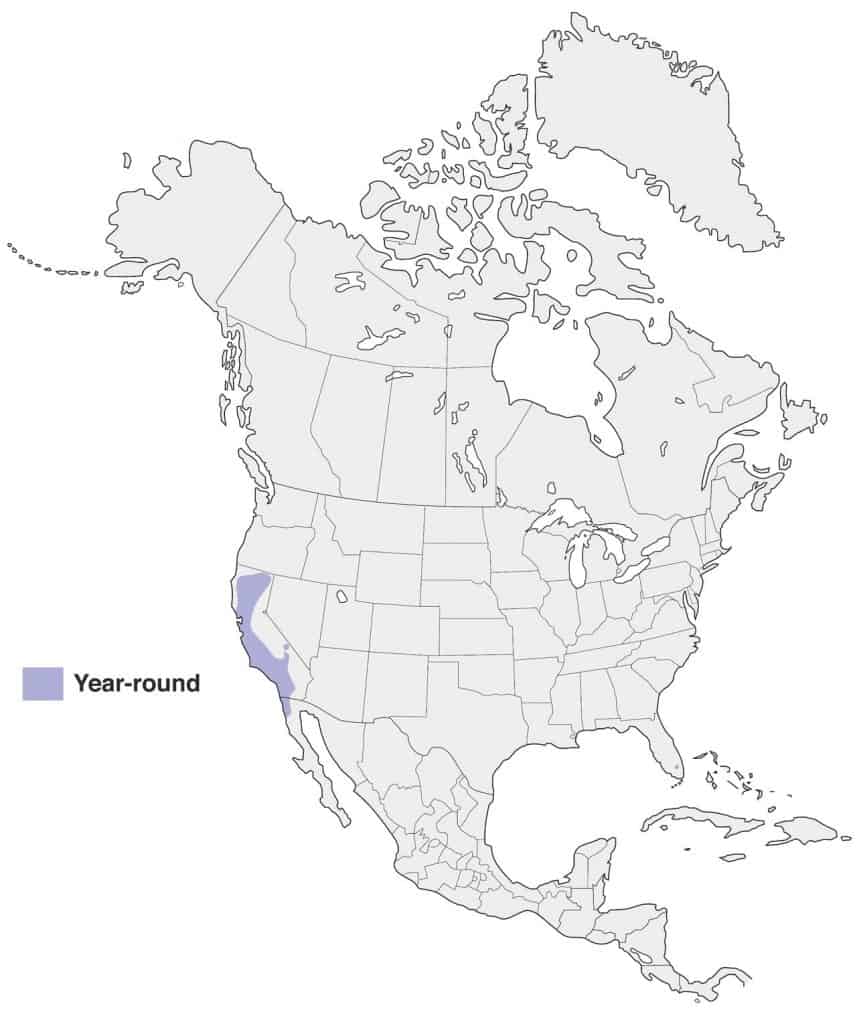
Pileated Woodpecker
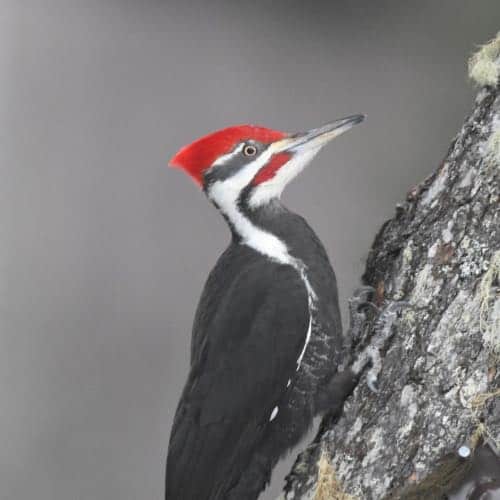
Appearance: A large bird about 19″ in length. They’re mostly black with white stripes on their face and neck with white underwings. The flaming red triangle-shaped crest is unmistakable and the male also has a red stripe on his cheek. The female is the same except her crest does not go all the way to her bill. And, she does not have a red stripe on her cheek.
Diet: Insects, especially carpenter ants.
Feeder food: Suet, shelled peanuts, safflower seed, sunflower seed, and
songbird fruit & nut seed mix.
Habitat: Forests and wooded areas that offer tall deciduous (leafy trees like maple & beech), coniferous trees (like evergreen & pine), and lower fruit & nut-bearing trees & shrubs.
Nesting: They excavate their own cavity in a tree. They have 3-6 white eggs per brood and incubate them for 15-18 days.
Migration: Pileated woodpeckers are not migrators. They remain in their year-round range every season of the year.
Year-round range: Canada’s southern provinces, the west coast of Washington, Oregon & California, and the eastern half of the US.
Range Map
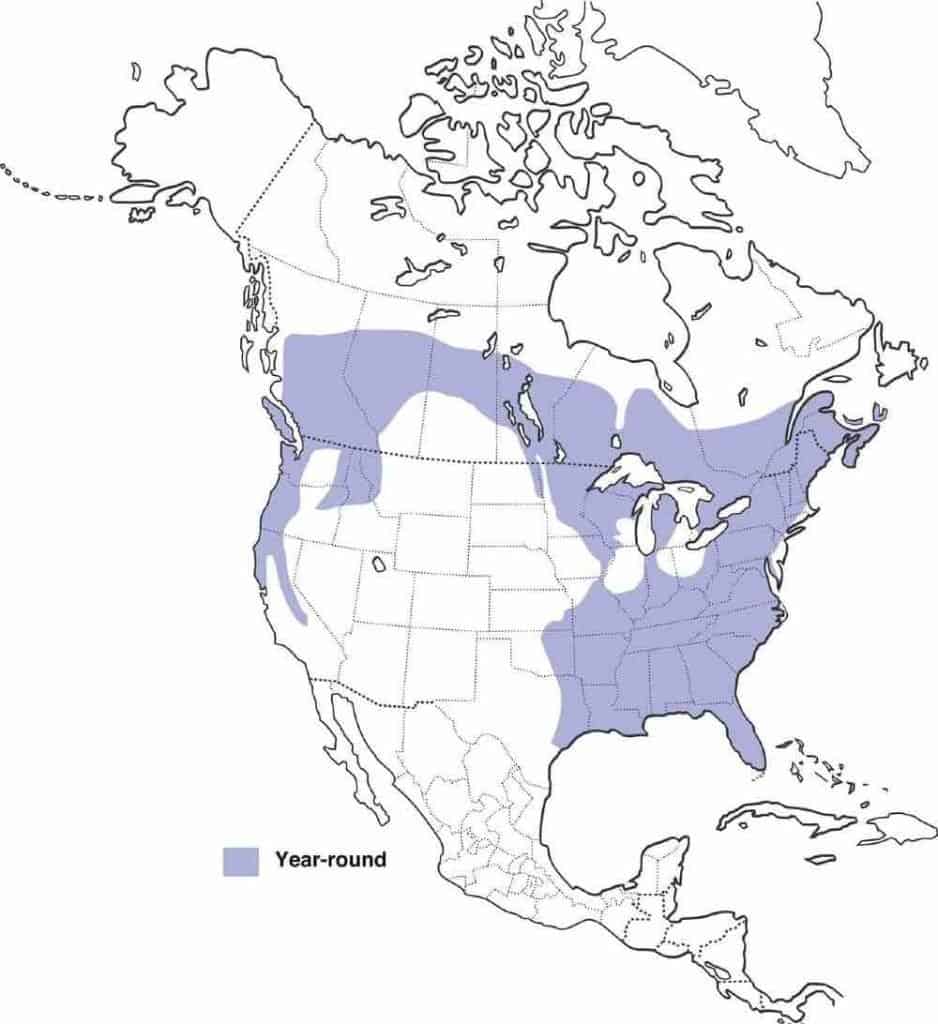
Pyrrhuloxia
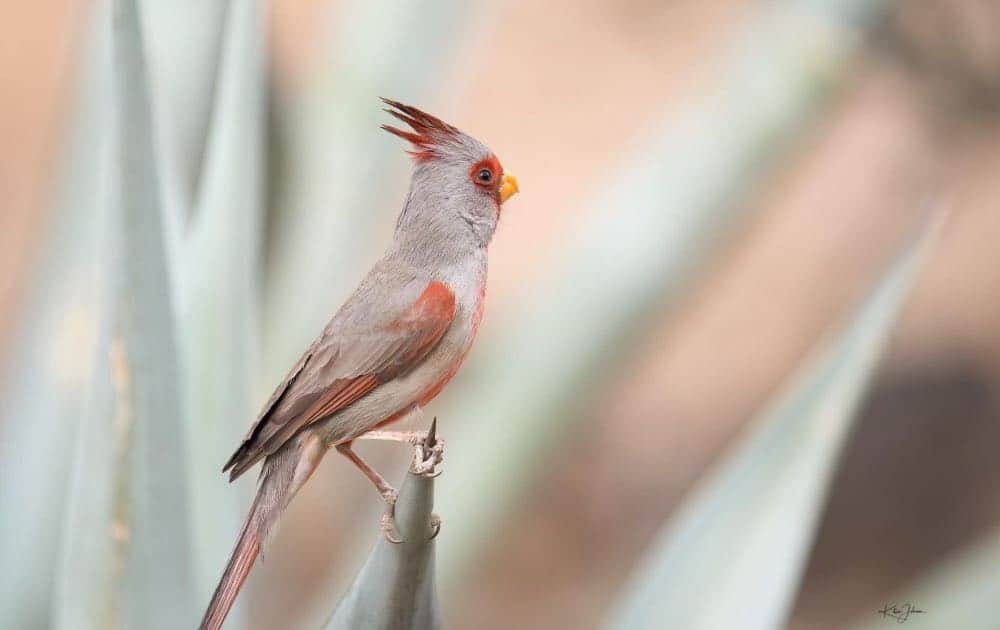
| Appearance | The Pyrrhuloxia is a medium-sized bird about 8″ long with a gray body, yellow bill, a ruby-red crown & mask plus stripes of rjuby-red on the wings and tail. The female looks the same except her mask is charcoal instead of red. |
| Diet | Seeds, fruits, and large insects. |
| Feeder Food | Black-oil sunflower seeds, hulled sunflower seeds, and cracked corn. |
| Habitat | Primarily dry areas including upland deserts, savannas, and thickets of mesquite shrubs & trees. |
| Nesting | They build a cup-shaped nest and have 1-2 broods/season. Each brood consists of 2-4 eggs that are gray/green with spots. Incubation is for 10-13 days. |
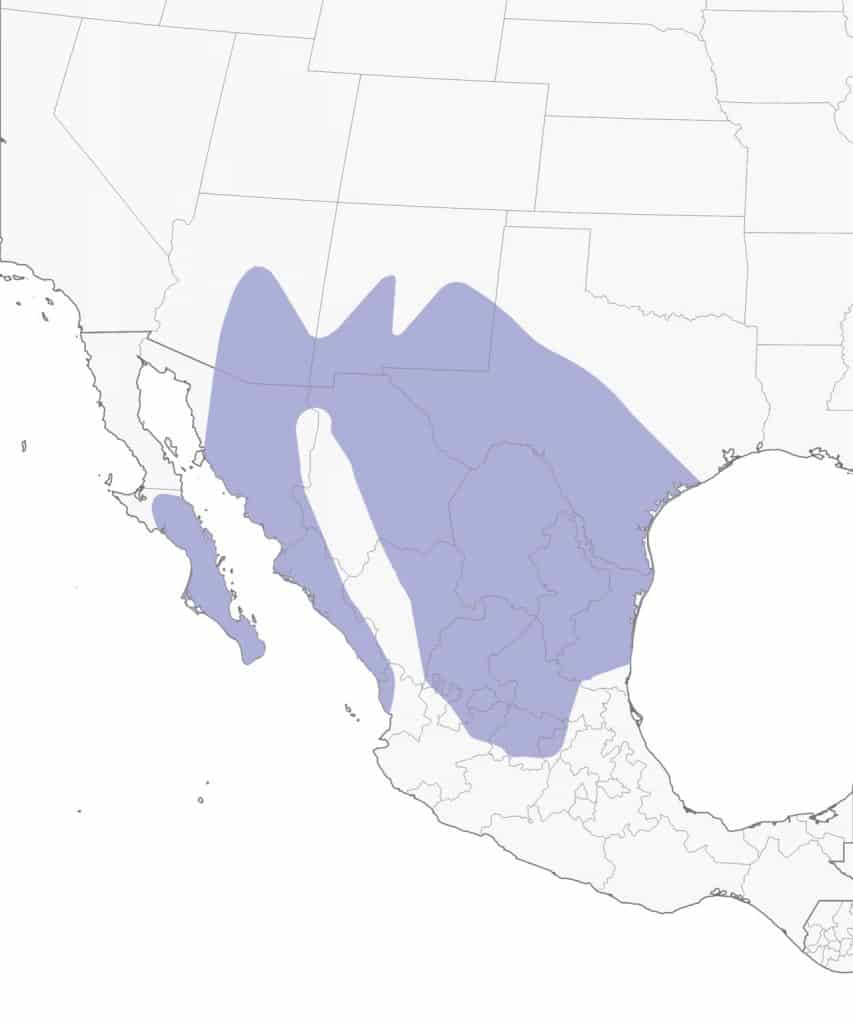
Red-Bellied Woodpecker
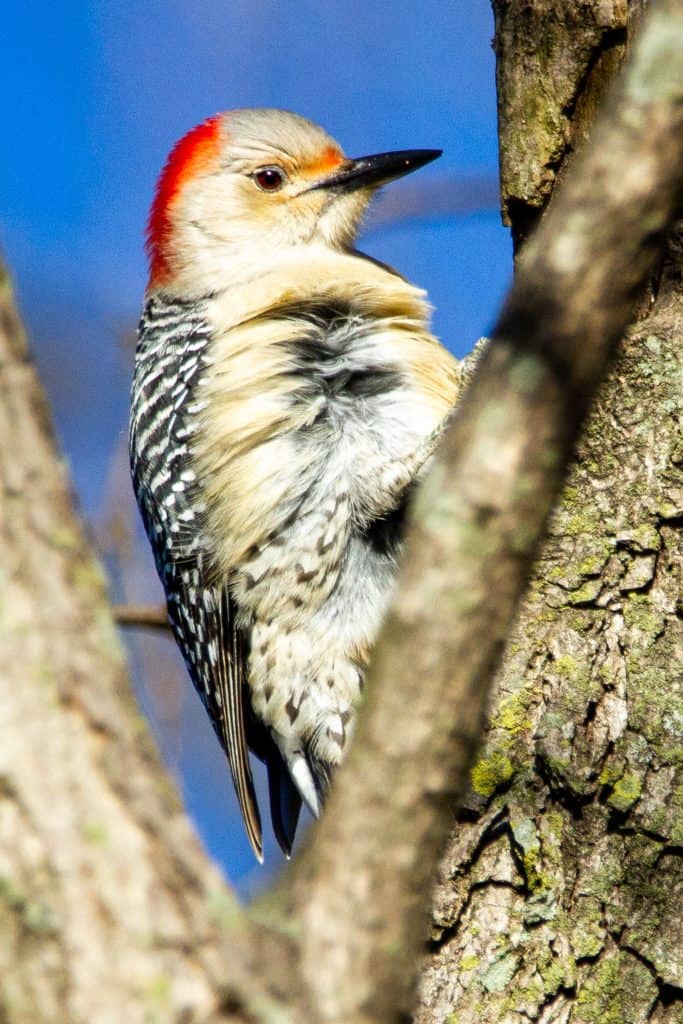
Appearance: The red-bellied woodpecker is a medium-sized bird about 9 1/4″ long. They have a zebra-like striped back with a white rump. The red crown extends down the nape of the neck. The chest is tan with just a tinge of red on the belly. The females are the same except they don’t have a red crown.
Diet: Insects, nuts, fruit.
Feeder food: Suet, hulled peanuts.
Habitat: In or near forests and woodlands.
Nesting: Red-bellied woodpeckers are cavity nesters and prefer dead trees or fence posts. They have 1-3 broods/year and 2-6 eggs/brood. Eggs are white without markings. Incubation is 12-14 days.
Migration: Red-bellied woodpeckers are not migrators. They remain in their year-round range all seasons of the year.
Year-round range: Eastern half of the US but not New England.
Range Map
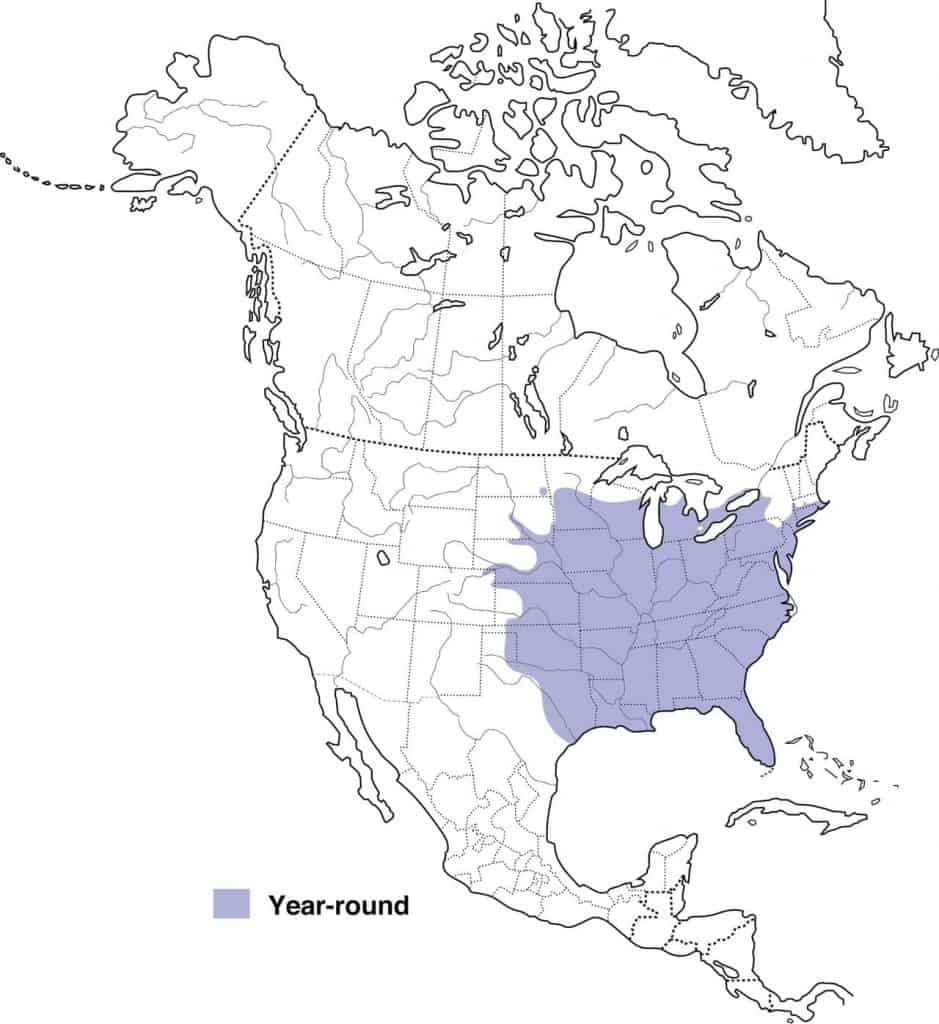
Red-Faced Warbler
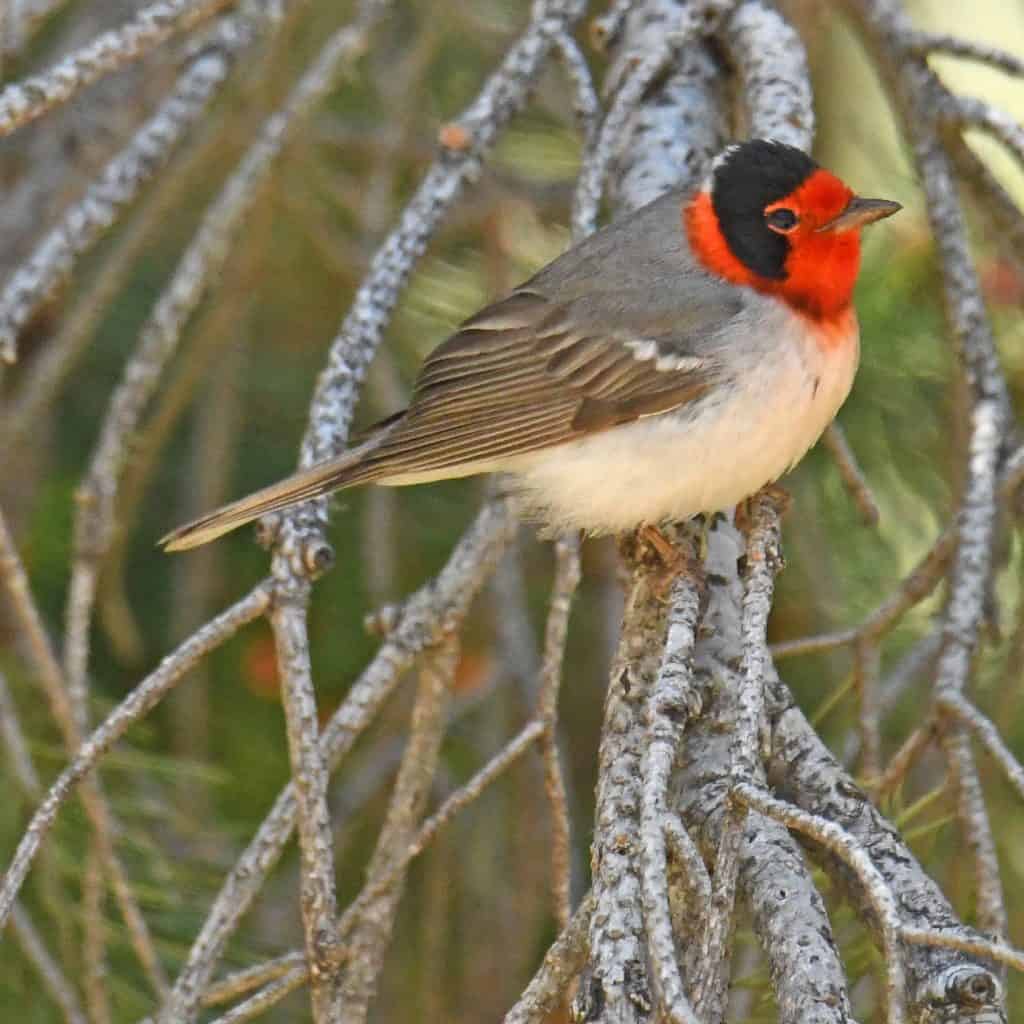
| Appearance | Red-faced warblers are tiny little birds about 5.5″ long. They have gray upperparts, brown wings, and a reddish-orange head with a brown band around the top and on its nape. Underparts are white, the beak is stubby & short while their tail is rather long. Females are similar except their face is orange rather than reddish-orange. |
| Diet | Insects. |
| Feeder Food | Unlikely to visit a feeder. |
| Habitat | Often found above sea level in the mountains of Arizona and New Mexico. They prefer pine and deciduous trees like oaks and aspen. They can also be found in canyons and other areas with streams. |
| Nesting | Nest: Small cup about 4″ x 2″, comprised of bark, leaves, and pine needles. Animal hair and soft grass line the nest. Clutch: 3-6 eggs/brood Egg color: Eggs are white with tiny brown specks – especially at one end. |
Range Map
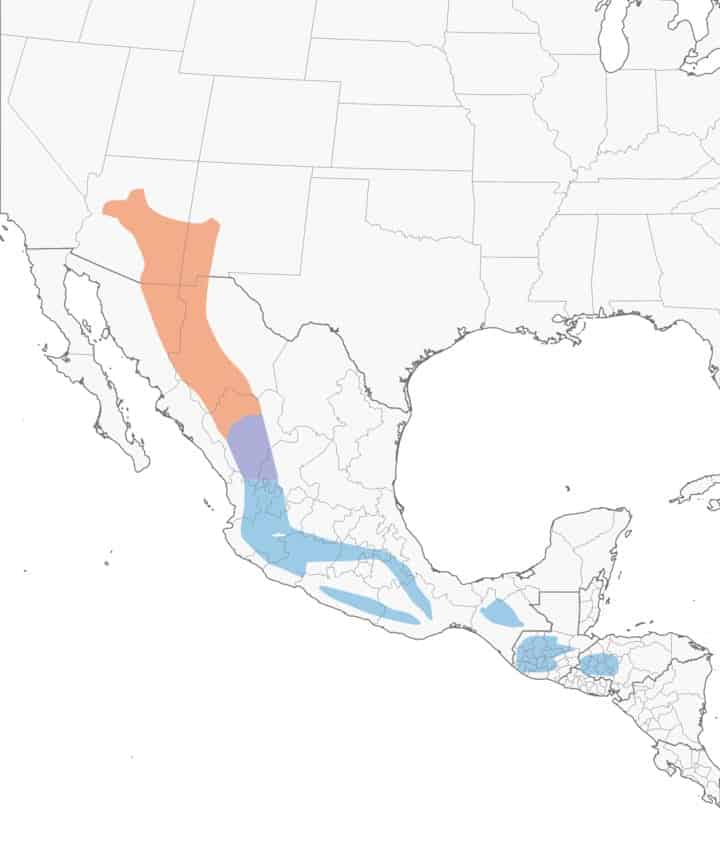
White-Headed Woodpecker
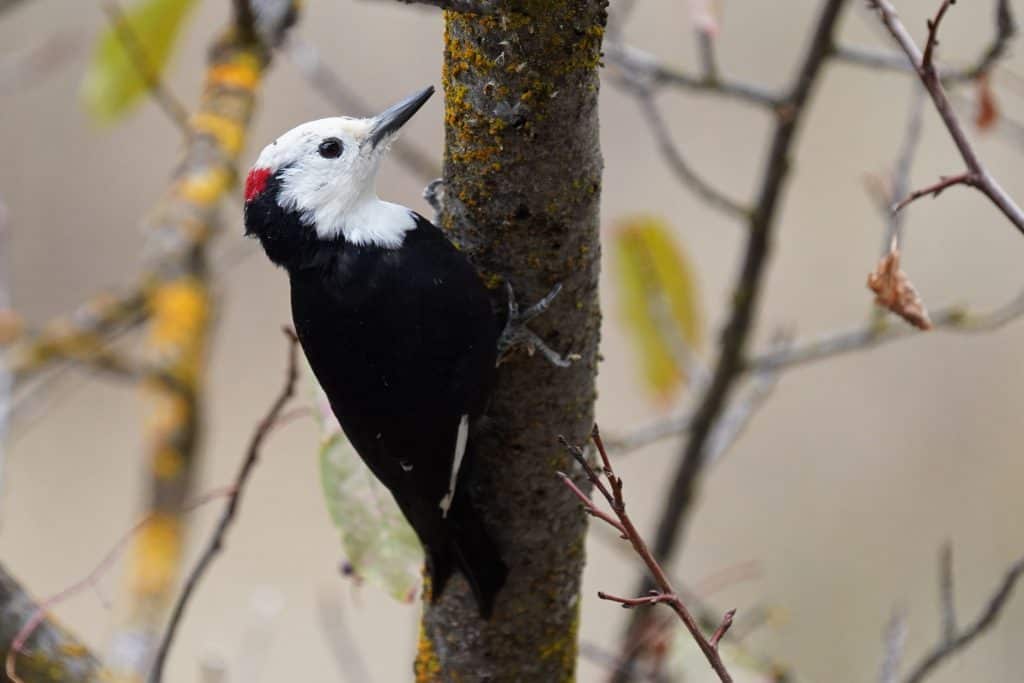
| Appearance | The white-headed woodpecker is a large bird about 9″ long with a black body, bright white head and white patches on its wings, a narrow red stripe from the back of the crown to the neck, and a black pointy bill. The female is similar except she does not have the red stripe on the crown. |
| Diet | Insects and pine seeds. |
| Feeder Food | Unlikely to visit a feeder. |
| Habitat | Coniferous mountain woodlands (especially pine trees). |
| Nesting | White-headed woodpeckers are cavity nesters, usually low in a large conifer tree. They have 1 brood/season with 2-9 white eggs. |
Range Map
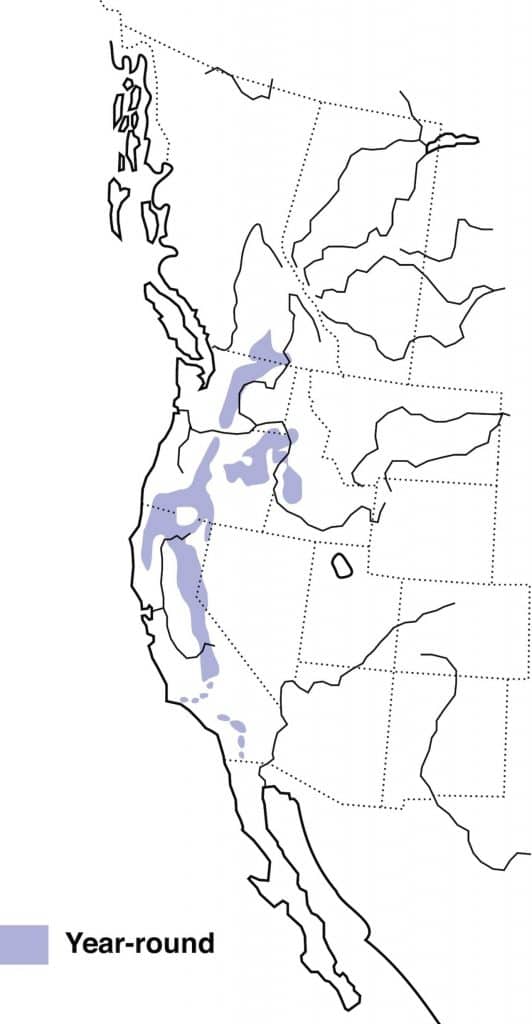
Yellow-Bellied Sapsucker
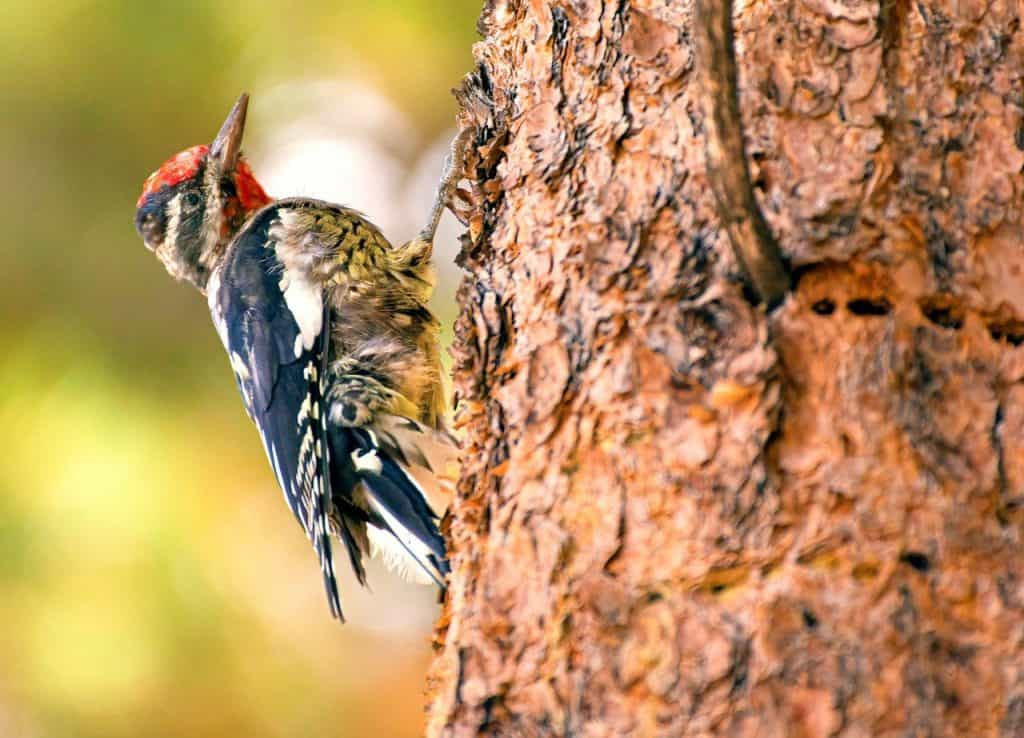
Appearance: Small bird about 8-9″ long with a checkered back. They have a red forehead, crown, and chin. The chest and belly are tan to yellow and have white wing patches. The Female is similar except she has a white marking on her chin.
Diet: Berries and fruit, bast (inner bark of a tree), few insects.
Feeder food: Suet.
Habitat: They prefer densely wooded areas with living trees (most woodpeckers prefer dead trees).
Nesting: They are cavity nesters and have 1 brood per year. 5-6 eggs/brood are all white. Incubation lasts 12-13 days.
Migration: Yellow-bellied sapsuckers are migrators. Right around mid-September through October, yellow-bellied sapsuckers migrate south for the winter. Then around the April-early May timeframe, they begin their migration north in search of ideal nesting conditions.
Breeding range: Eastern Alaska, North Dakota, Minnesota, Wisconsin, Michigan, Virginia, Pennsylvania, New York, New England, and all Canadian provinces (except Nunavut),
Winter range: Nebraska, Missouri, Illinois, Indiana, Ohio, Arkansas, Oklahoma, Texas, Louisiana, Mississippi, Alabama, Georgia, Florida, North Carolina, South Carolina, Virginia, Maryland, Delaware, and New Jersey.
Range Map
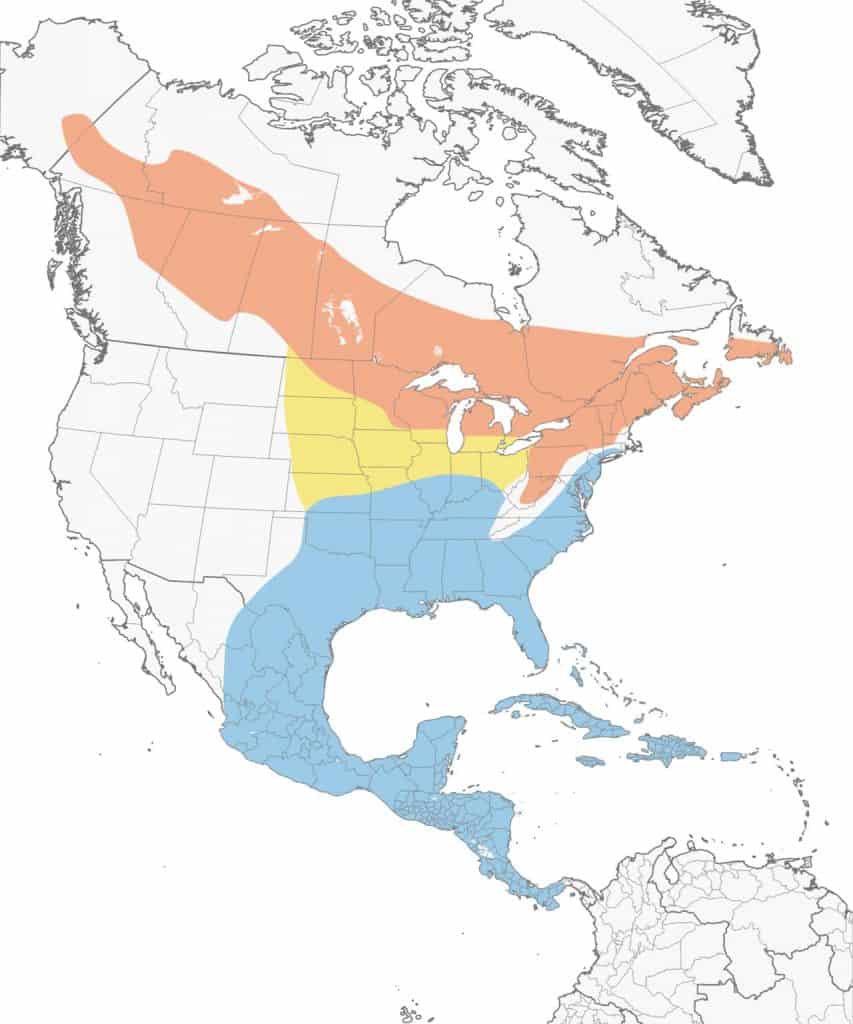
Hopefully, you’ve identified the red-headed bird from this article or just broadened your knowledge of red-headed birds in North America. If you want to see more of a particular species of red-headed bird, consider taking steps to attract them.
How to Attract Northern Cardinals
How to Attract Pileated Woodpeckers
How to Attract Northern Flickers
How to Attract Downy Woodpeckers
Happy Birding!

